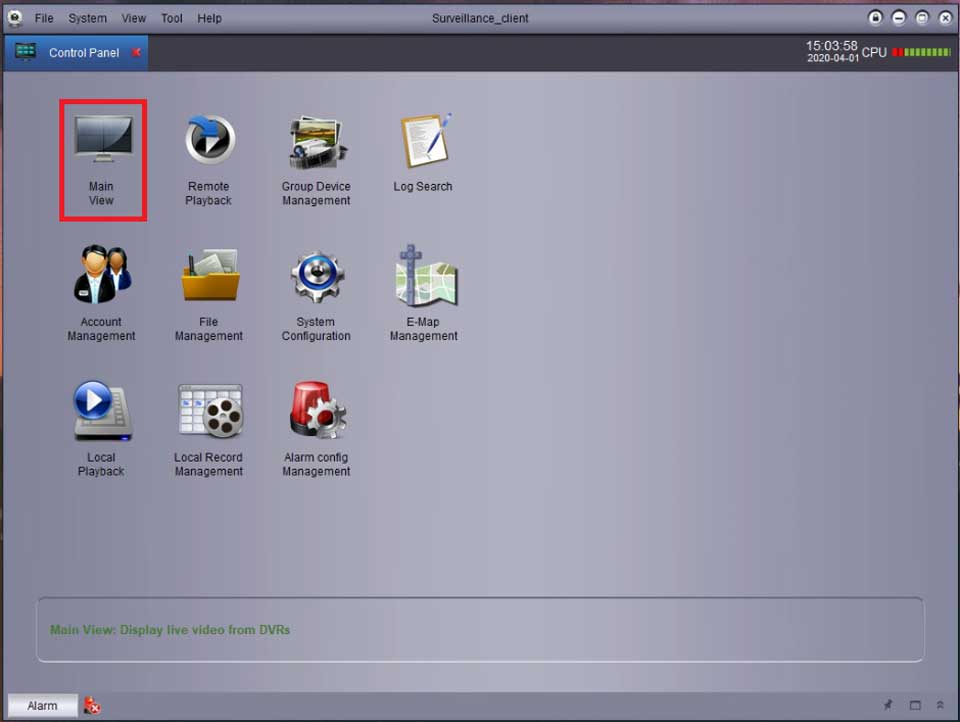Gamut Surveillance Client Guide,This guide will show you how to access the live footage, recordings and settings of your Gamut camera or recorder, using a Windows or Mac computer.
Before You Begin
Your Gamut device will need to be turned on and connected to your internet router. You will need to use a TV to set up the recorder for the first time, follow the quick start guide to do so. After the initial setup, a TV or monitor is not necessary when accessing the recorder via a network connection.
If you are using a recorder and cameras, make sure that the cameras are connected and working.
If you are using a Wi-Fi bridge system with your camera, make sure that the bridges are turned on, wired correctly and communicating before you begin.
Let’s Get Started
Now that you have connected your recorder/camera to your internet router and turned it on, you will be able to view it using a program called Surveillance Client.
First you will need to download some software called Device Config Tool, which will allow you to find out the IP address of the camera/recorder and edit some of the settings.
Download it from here if you are using Windows, and here if you are using a Mac.
Once the software has been downloaded and installed, you will see a window like the screenshot below. Make a note of the camera/recorders IP address.
Gamut Surveillance Client Guide
Read More :
- Bosch BVMS Lite Operation manual
- How to Set Up 2M Live
- Tiandy Easy7 Smart Client Express User Manual
Thank you for using Surveillance_client series products. Please carefully read the software operation manual before operation.
As the software may be updated at any time, the contents of the operation manual are subject to change without prior notice.
Disclaimer:
The company has sought to the integrity and accuracy of the contents of the operation manual during the compilation process and will not be held liable for any errors or omissions. The company reserves the right to change the software mentioned in the operation manual at any time without prior notice. Thank you for choosing our products. Please carefully read this manual before operation. We assume no economic and legal responsibility for the losses caused by the operation not according to the stipulations.
The files for software installing, running, recording and sharpshooting are in the following folders by specific paths.
The default software installation path: C:\Program Files\Dvrsoft\Surveillance_client. User can define the path for installation.
Requirements for system configuration:
Hardware
CPU: Intel Core 2 Duo 2.4GHZ or Higher
RAM: 2GB or higher
VGA: DirectX 9.0 compatible VGA card, NVIDIA GeForce 9500GT or higher, with video memory of 512MB or larger
(Make sure the graphics driver provided by the computer supplier has been installed.)
Network Card: Recommend to use gigabit NIC, (including network card, router, switch and network cables of 5e or higher specifications for RJ45 port)
Disk Space: At least 1GB space should be available except the required space for recording.
OS: Window Vista Business, Enterprise, Ultimate (32 bit or 64 bit)
Window 7 Professional, Enterprise, Ultimate (32 bit or 64 bit)
Window 8, Window 8 professional, DirectX 9.1 or higher
Mac OS: 10.6 or higher
– 4 –
Surveillance-client Software Operation Manual
In consideration of the functions and features of the software, we strongly recommend that:
- All the operators should be trained so as to avoid forming the artificial weak point of protection system.
- Sound user management mechanism and level should be established and the low level user’s access should be restricted so as to avoid the possibility of the incorrect operation.
Double click the installation file “Surveillance_client_1.0.23_2013_07_30” to install the software.
1 The following window will be popped up.
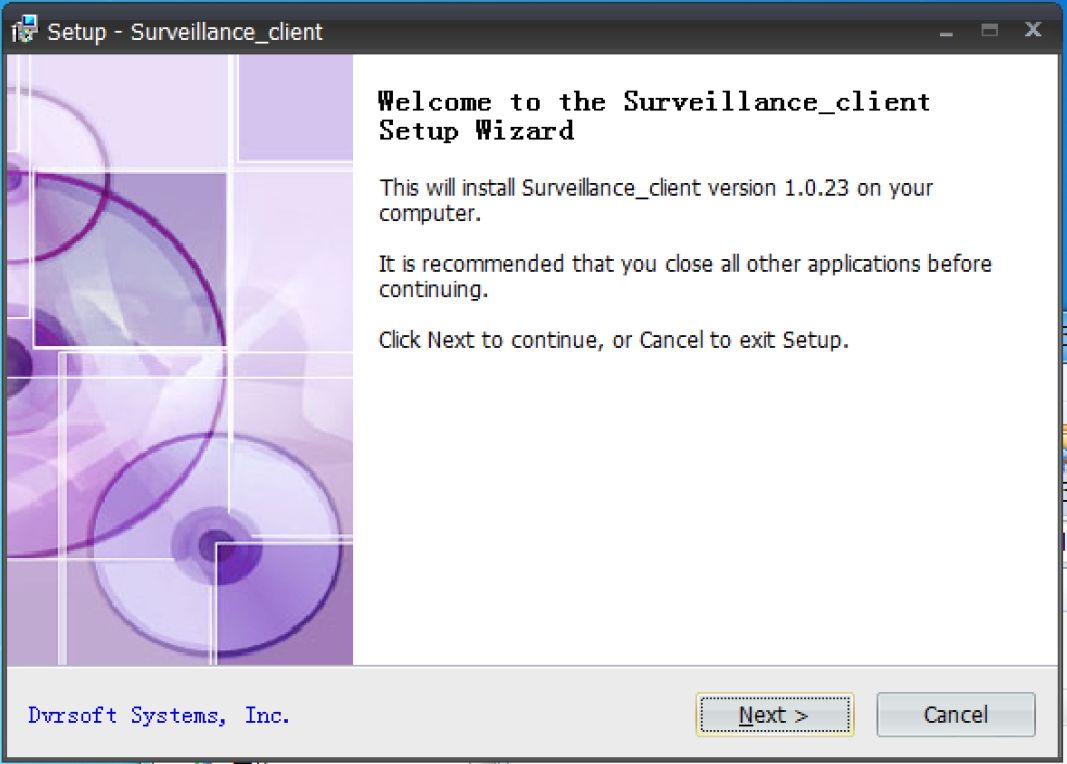
Fig.3-1
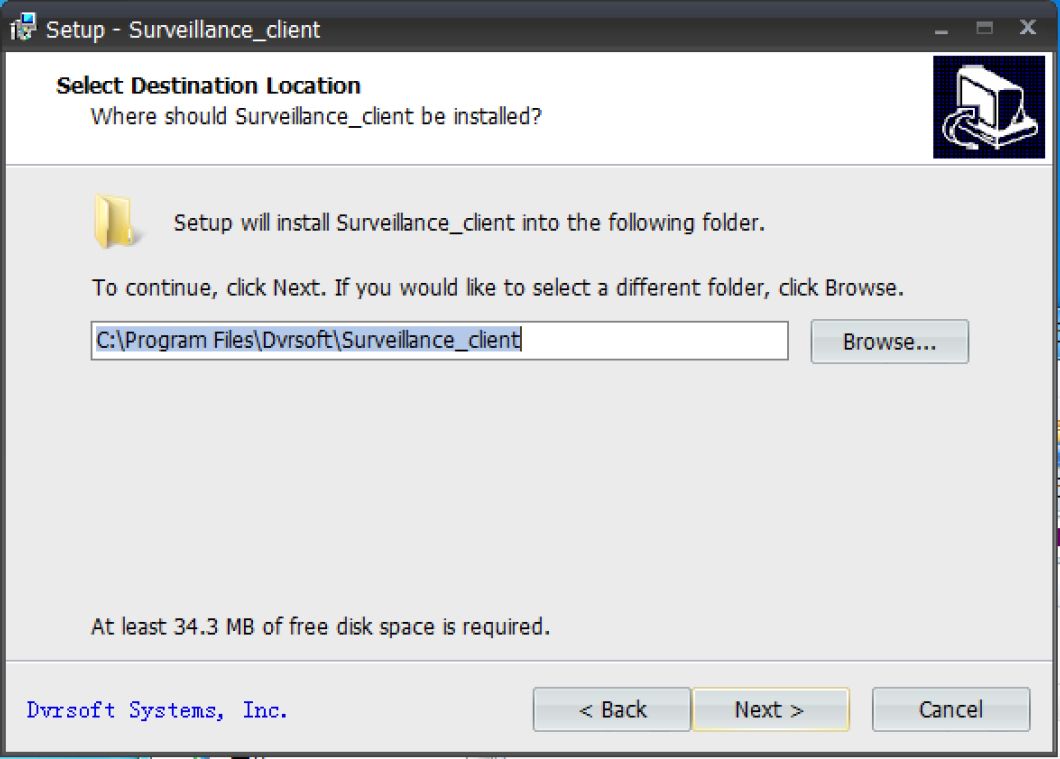
Fig.3-2
– 5 –
Surveillance-client Software Operation Manual
- The system default installation path: System disk:\ Program Files\Dvrsoft\Surveillance_client. To change the installation path, please click Browse to customize. (Fig. 3-2)
Confirm the installation path and then click Next.
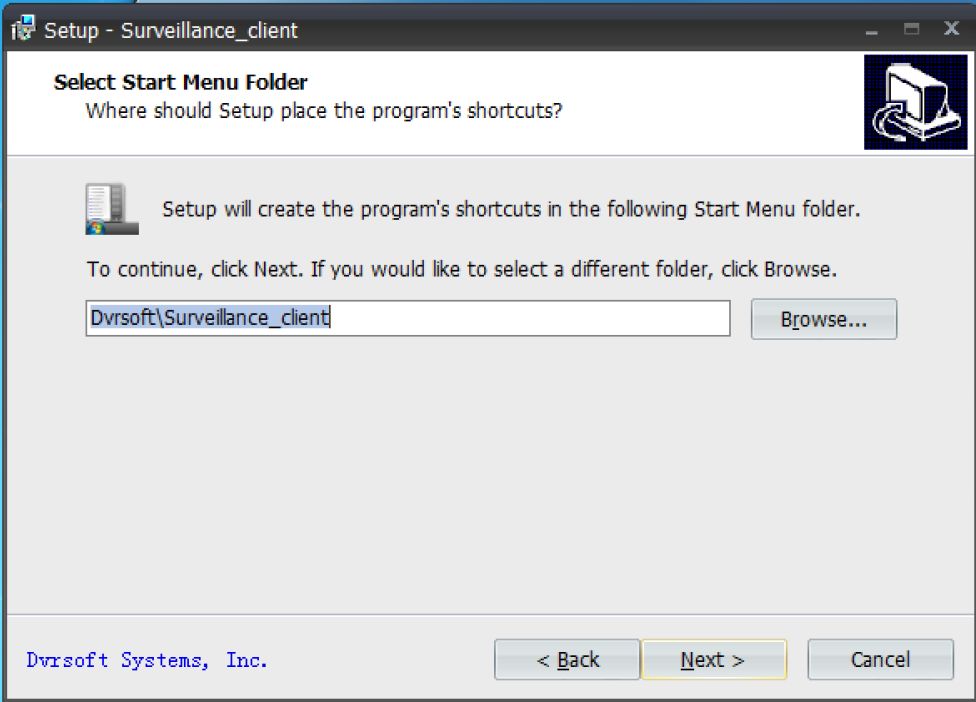
Fig. 3-3
5. The program’s shortcut will be created in the following Start Menu folder. The default installation path
is Dvrsoft\Surveillance_client. If you want to select a different folder, please click Browse to customize.
(Fig. 3-3)
Confirm the installation path and then click Next.
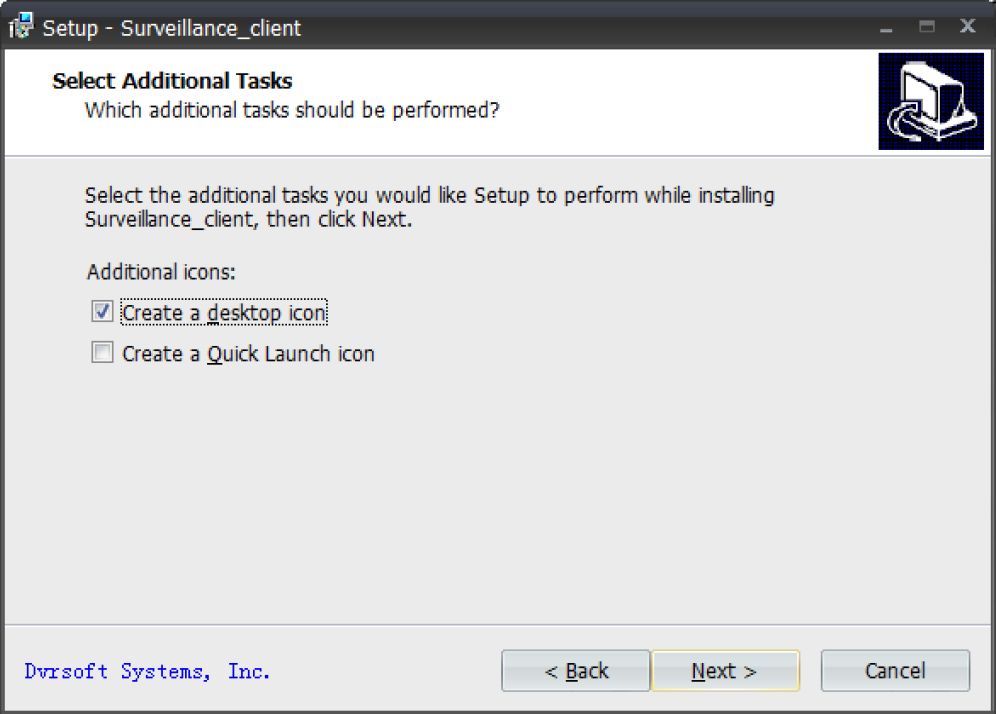
Fig. 3-4
- Select the additional tasks you would like Setup to perform while installing Surveillance_client.
Additional icons: 1. Create a desktop icon, 2. Create a Quick Launch icon. (Fig.3-4)«
- Click Install to start installation. (Fig. 3-5)
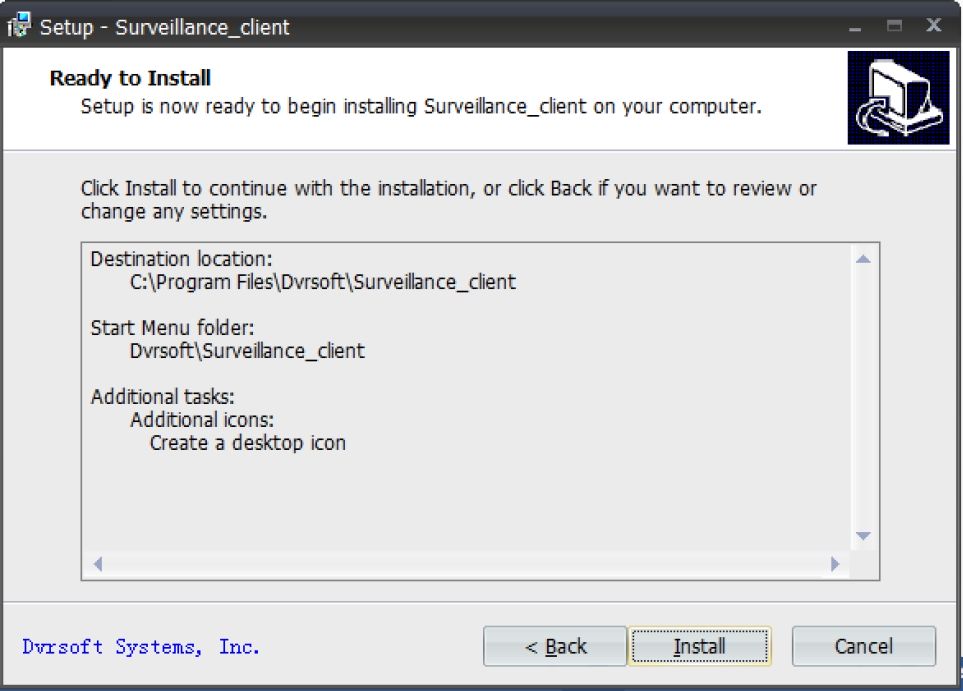
Fig. 3-5
– 6 –
Surveillance-client Software Operation Manual
- After software setup finished, the following window will be popped up. Click Finish to exit Setup. (Fig.
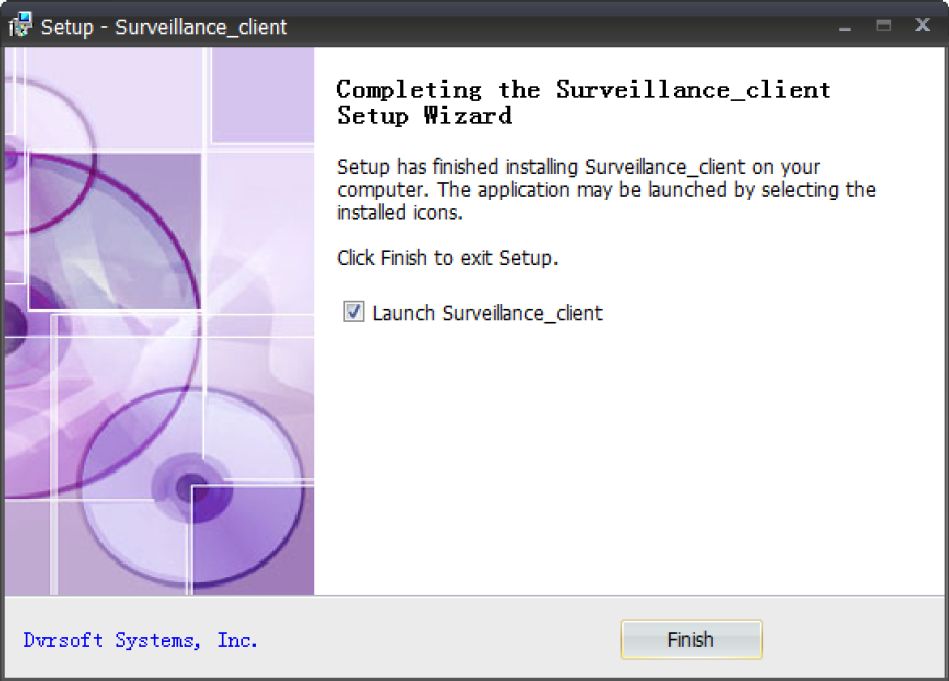
Fig. 3-6
User can uninstall the software in Add and Remove Programs of the Control Panel.
User can also run the Uninstall program by the following steps:
1.
Click Start button ->All programs^ Dvrsoft\Surveillance_client^ Uninstall Surveillance_client, the
following window will be popped up. Click Yes.
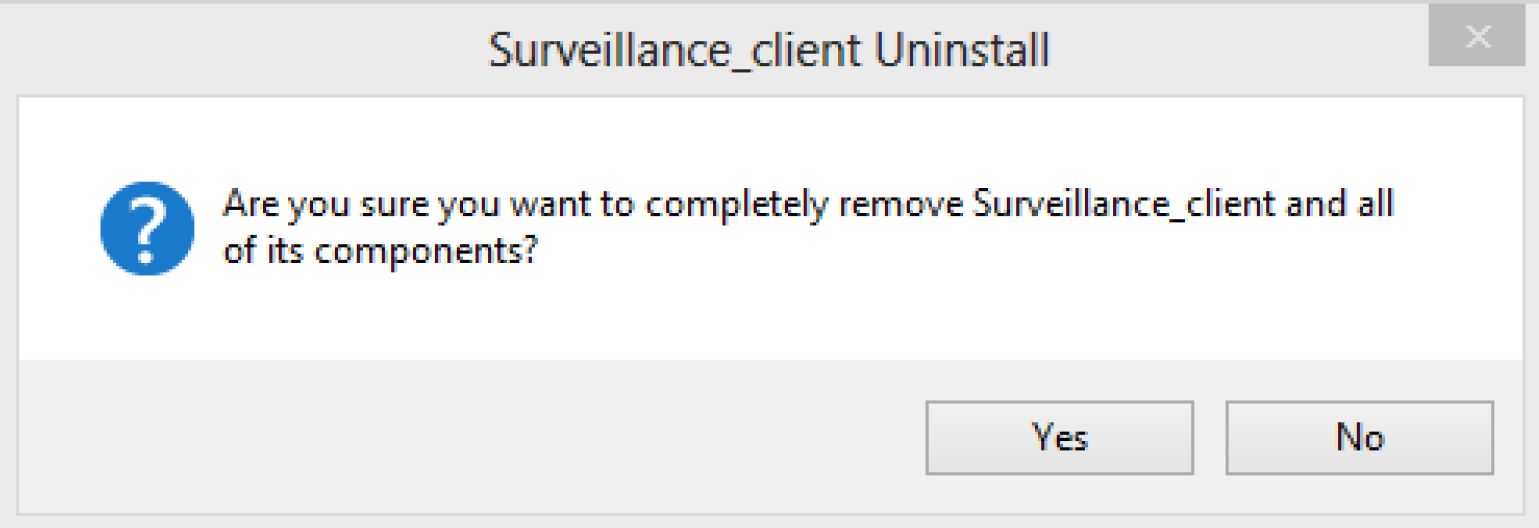
Fig. 3-7
System starts uninstalling the software and the process will be automatically finished.
2.
In this chapter, we’ll learn the specific operation of Surveillance_client.
After installation is finished, a shortcut for Surveillance_client will be generated on the desktop. Run the program by double clicking the shortcut Surveillance_client on the desktop or click Start ->All Programs^ Dvrsoft\Surveillance_client ^ Surveillance_client.
Run the software for the first time
– 7 –
Surveillance-client Software Operation Manual
Please start the program Surveillance_client.
1. Click Login. No password by default.
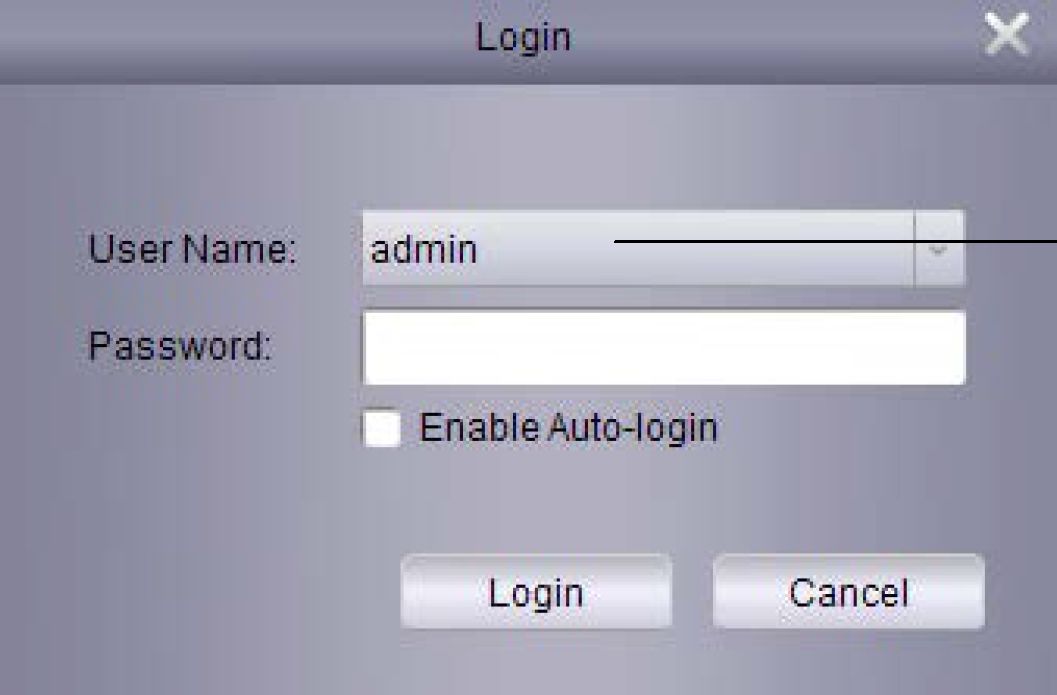
Fig. 4-1
Click Login
1. Run Surveillance_client and Add Device Wizard will be opened. Click Next.
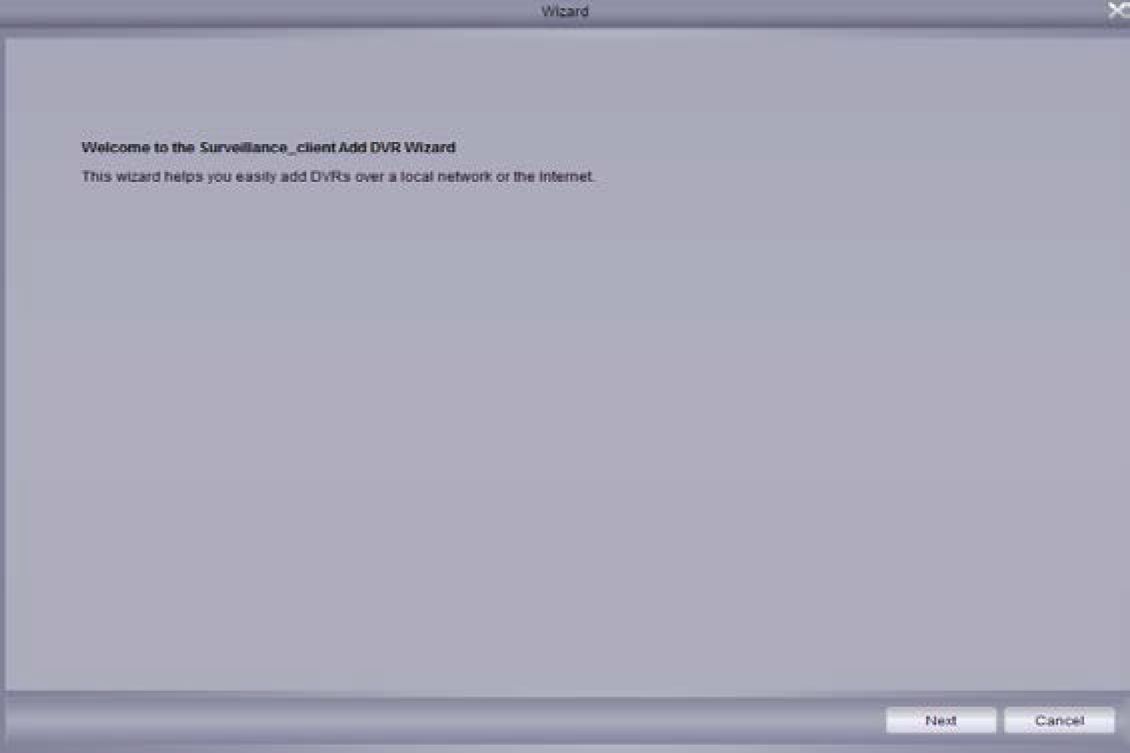
Fig. 4-2
Note: If Add Device Wizard is not opened, please single click Help to manually open it.
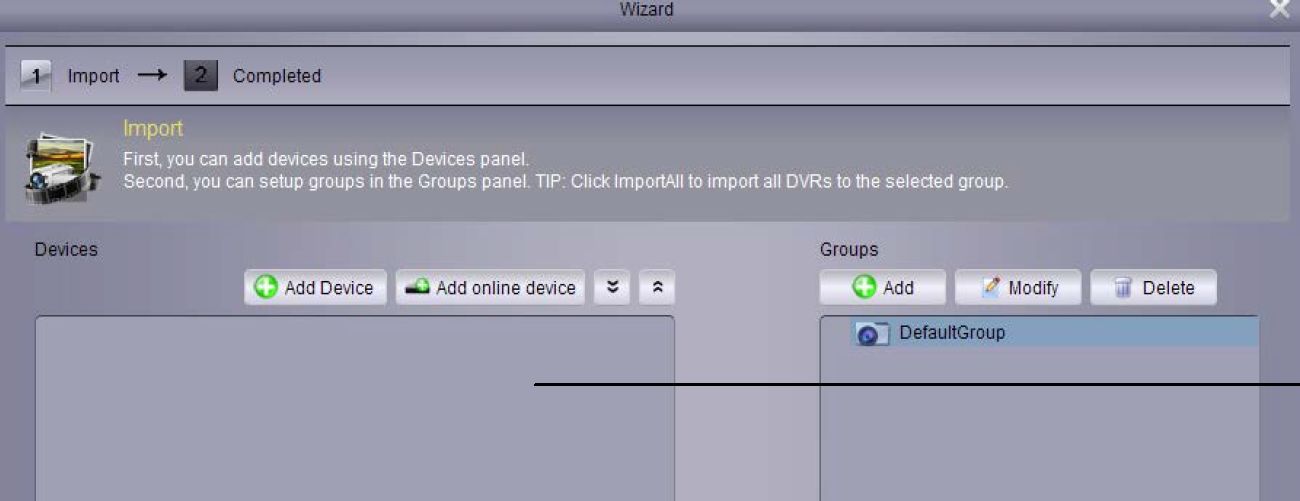
Display online devices
Fig. 4-3
– 8 –
Surveillance-client Software Operation Manual
- Click a DVR in the list and the added devices, IP address, port and channel number will be displayed. Click Add Selected Device to add.
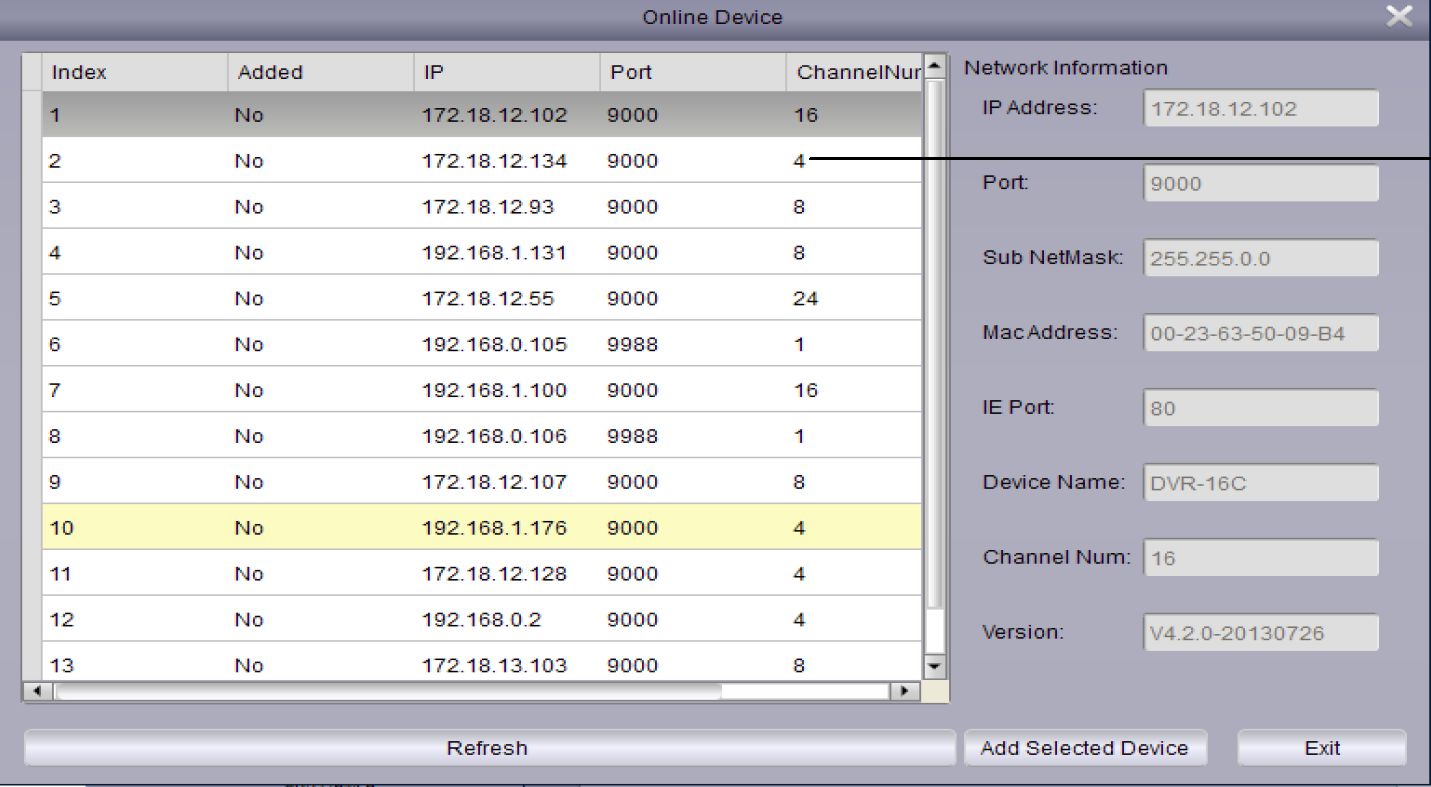
Fig. 4-4
Click a DVR in the list.
Note: If your DVR is not available in the list, click Exit and then click add to manually input the IP address of DVR.
- Input the name of the selected DVR in Device Name field, e.g. home, office, etc.
- Input user name in User Name field (default name is admin)
- Input password in Password field. The password field is blank by default. You may change the login password of DVR.
– 9 –
Surveillance-client Software Operation Manual
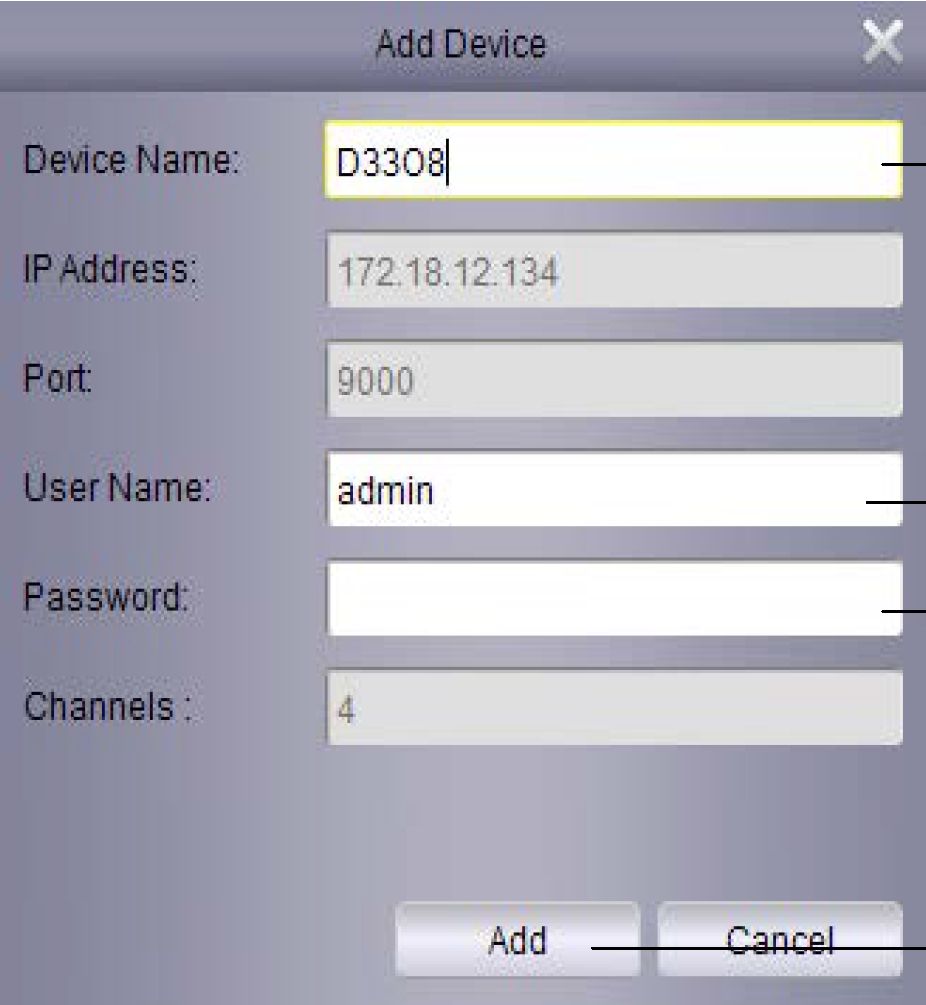
Fig. 4-5
Input the name of your DVR
Input user name (admin by default)
Input password if the password verification is activated.
Click Add
2. Click ImportAll to import all DVRs to the default group.
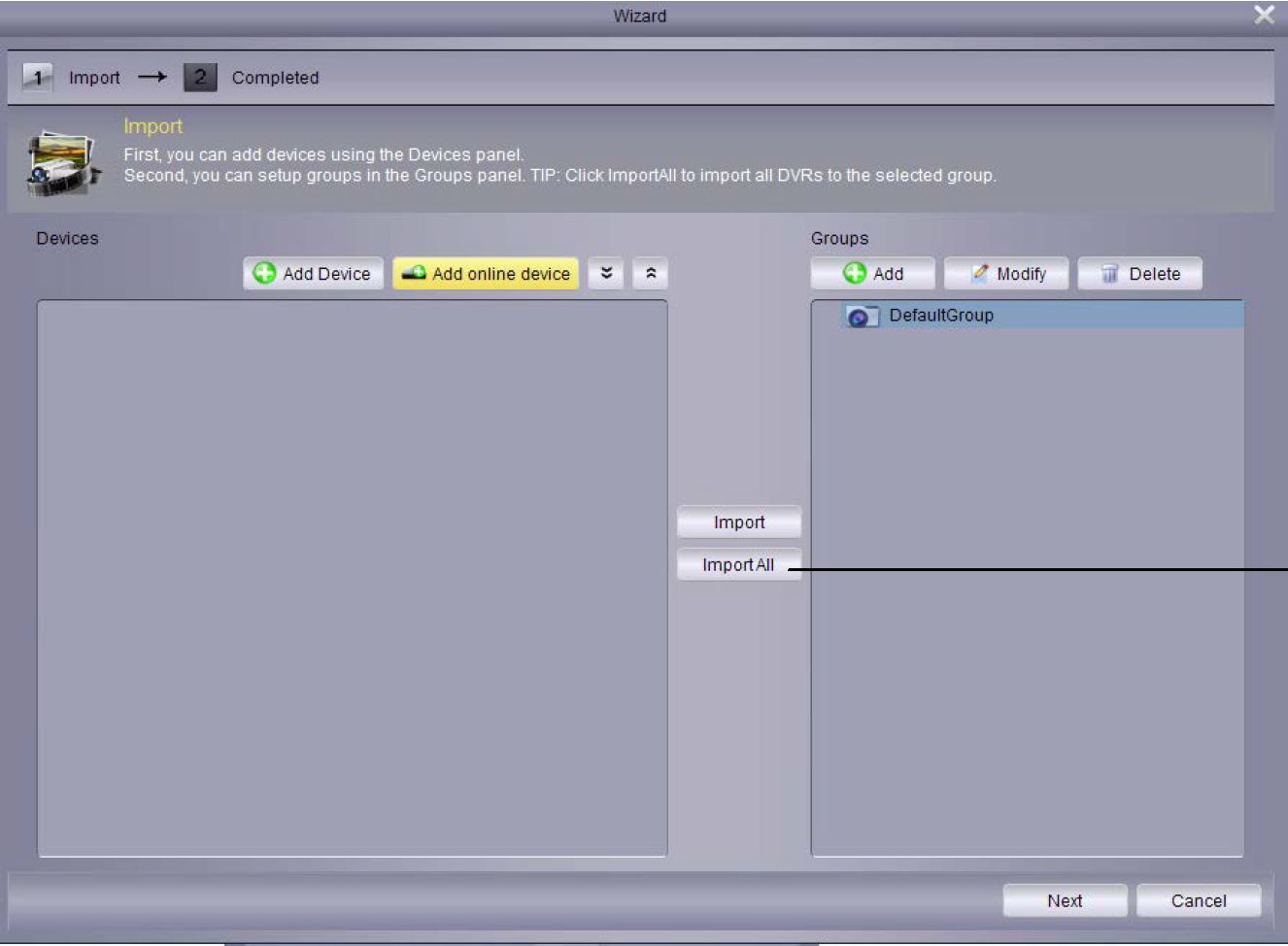
Fig. 4-6
Click ImportAll
– 10 –
Surveillance-client Software Operation Manual
1. Click Main View
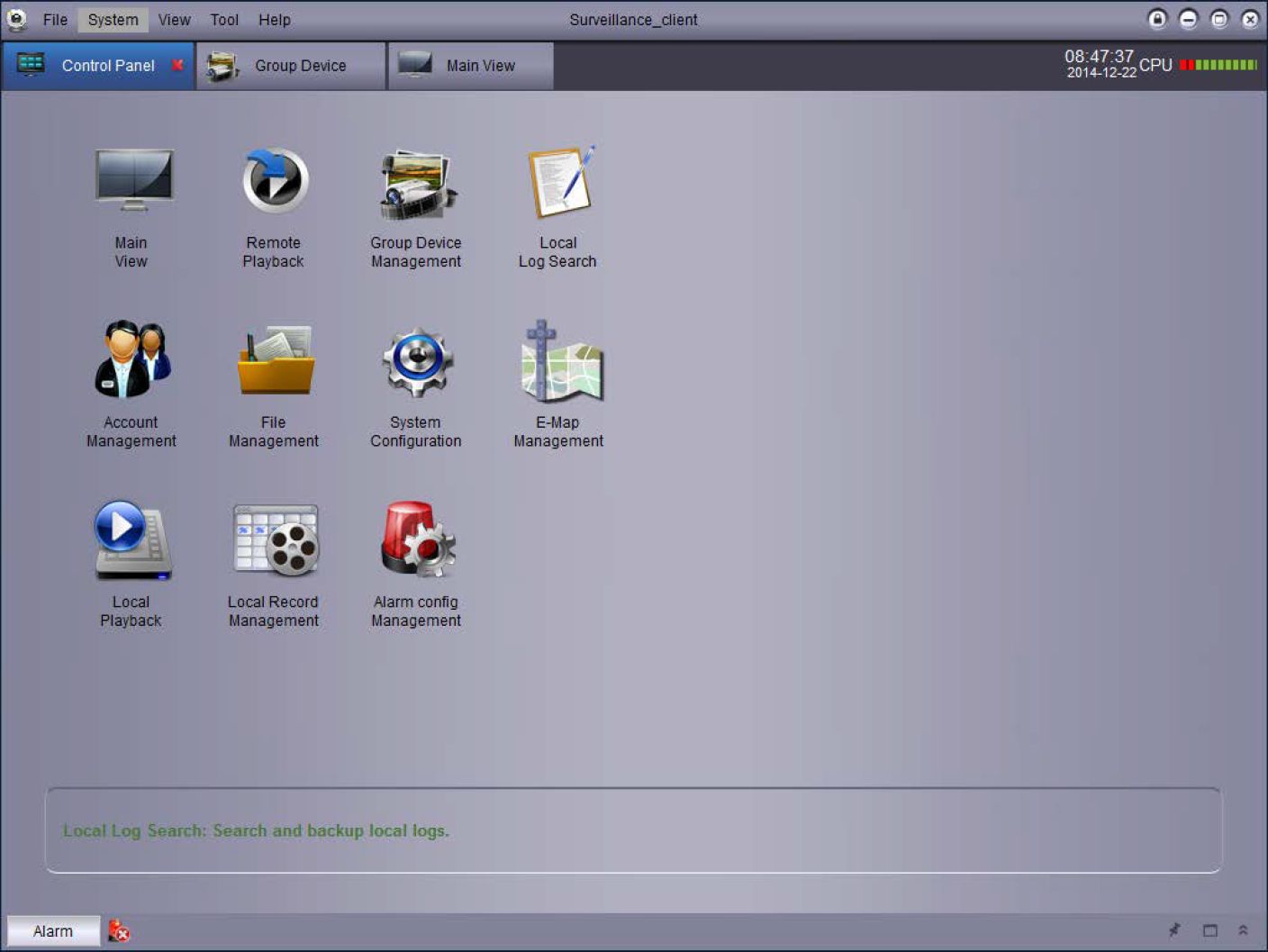
Fig.5-1
2. Click and drag it to the default group in the show grid.
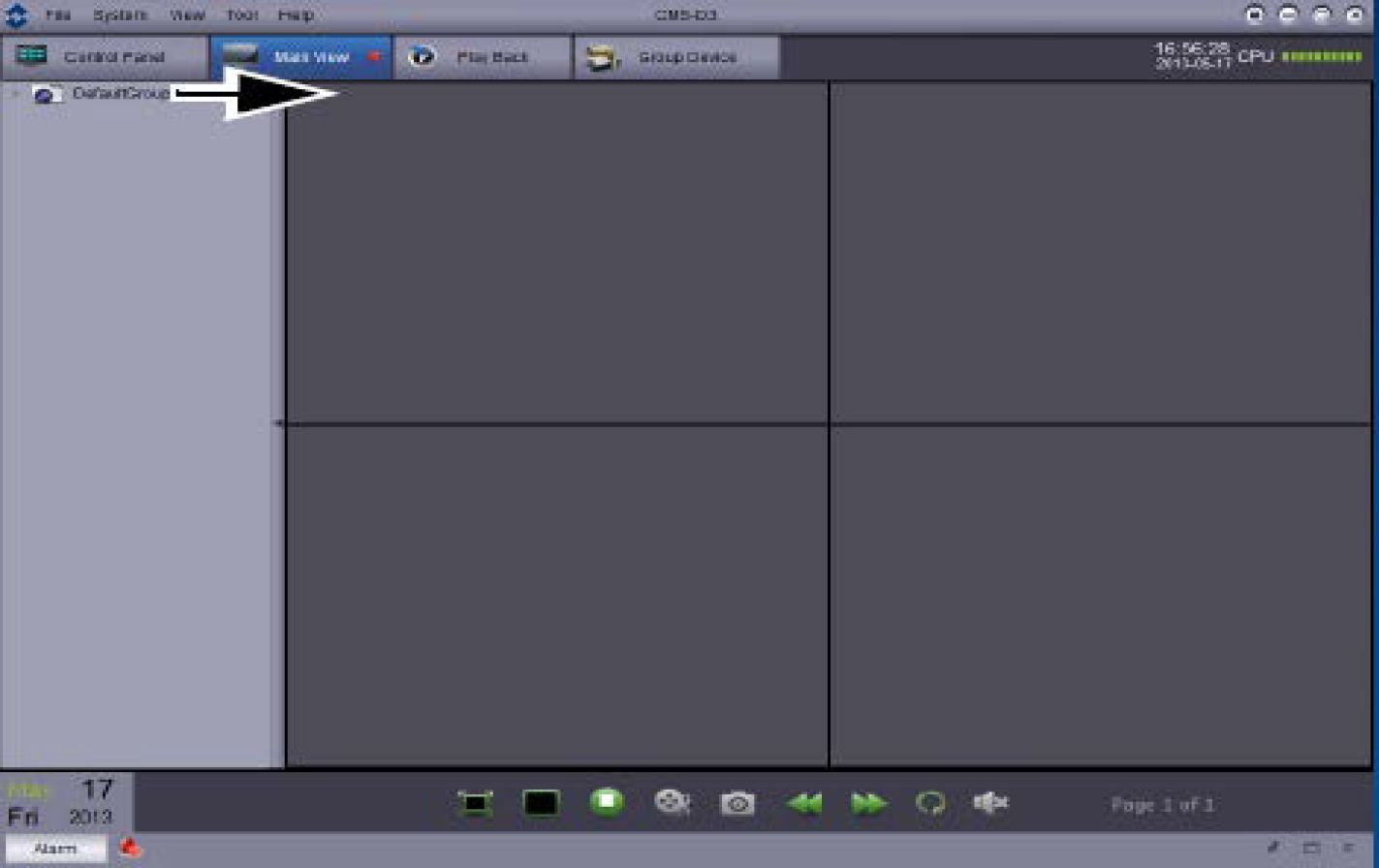
Fig. 5-2
– 11 –
Surveillance-client Software Operation Manual
If DVRs use dynamic domain names, you may add them into Surveillance_cliento Preconditions:
Add a DVR by using DDNS:
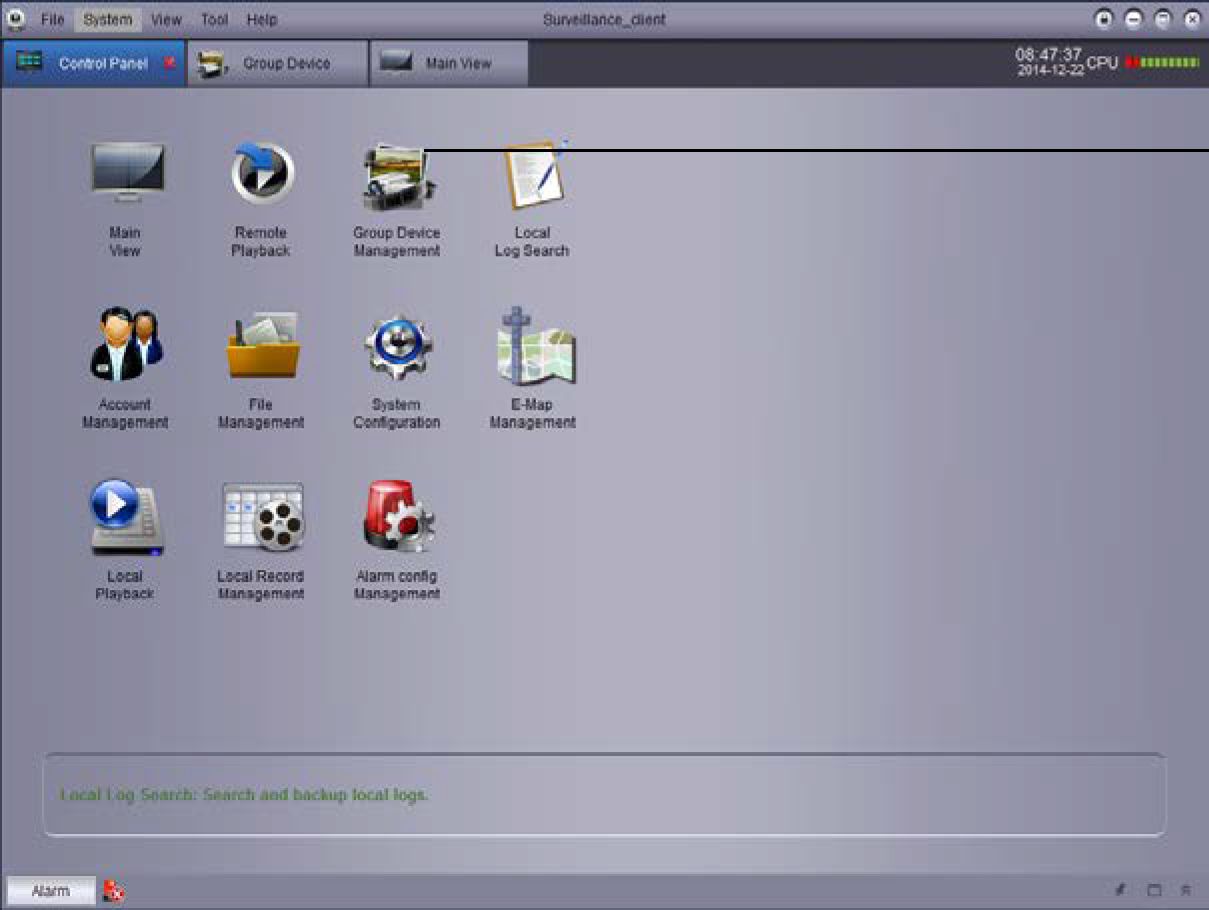
Click Group Device
Management
Fig. 5-3
– 12 –
Surveillance-client Software Operation Manual
3. Configuration:
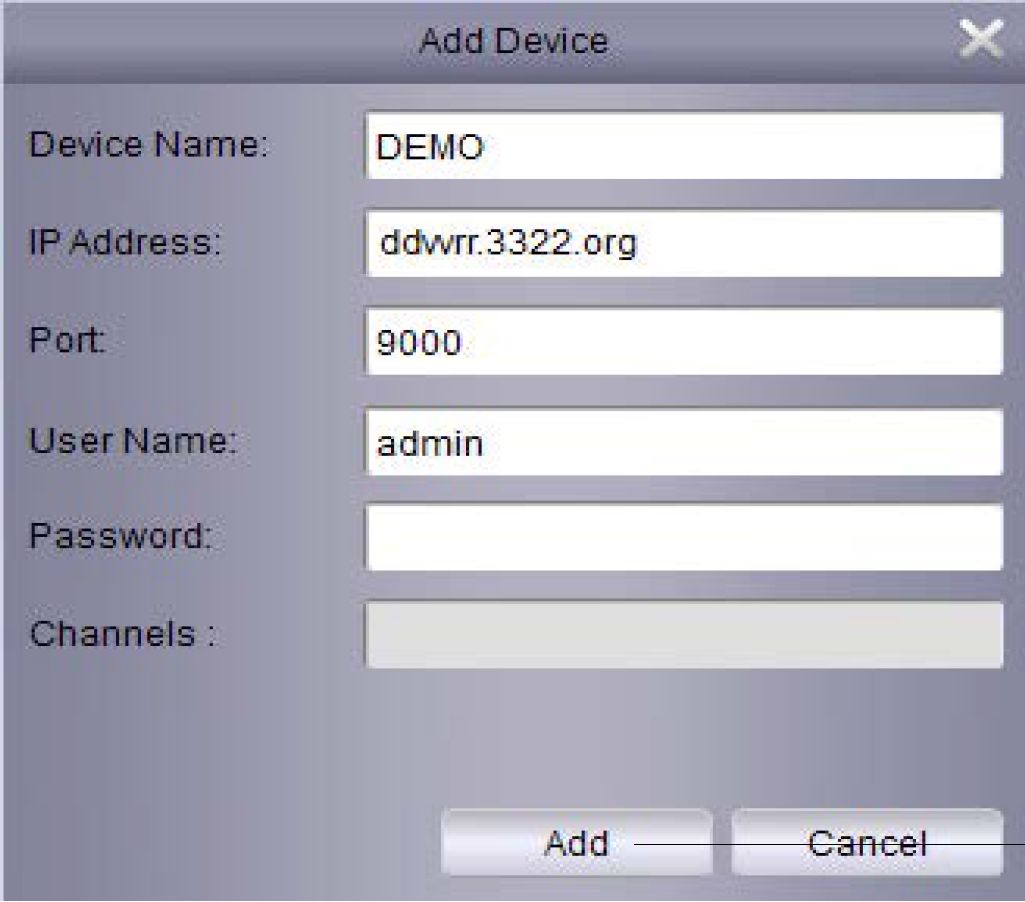
Fig. 5-4
Input the name of your DVR
Input IP adress
Input the port of the client (Default
value: 9000)
Input user name (admin by default)
Input password (default: blank)
Click Add
- Device Name: Input the name of your DVR, e.g. home, office, etc.
- IP Address: Input domain name, for example, ddvvrr. 3322.org.
- Port: Input the client port of DVR (Default: 9000) .
- User Name: Input user name (admin by default).
- Password: Input password. The password field is blank by default unless the password verification has been activated for DVR.
- Click Add.
- Click import all to import all DVRs to the default group.
- Click ‘Control Panel’ option.
- Click Main View.
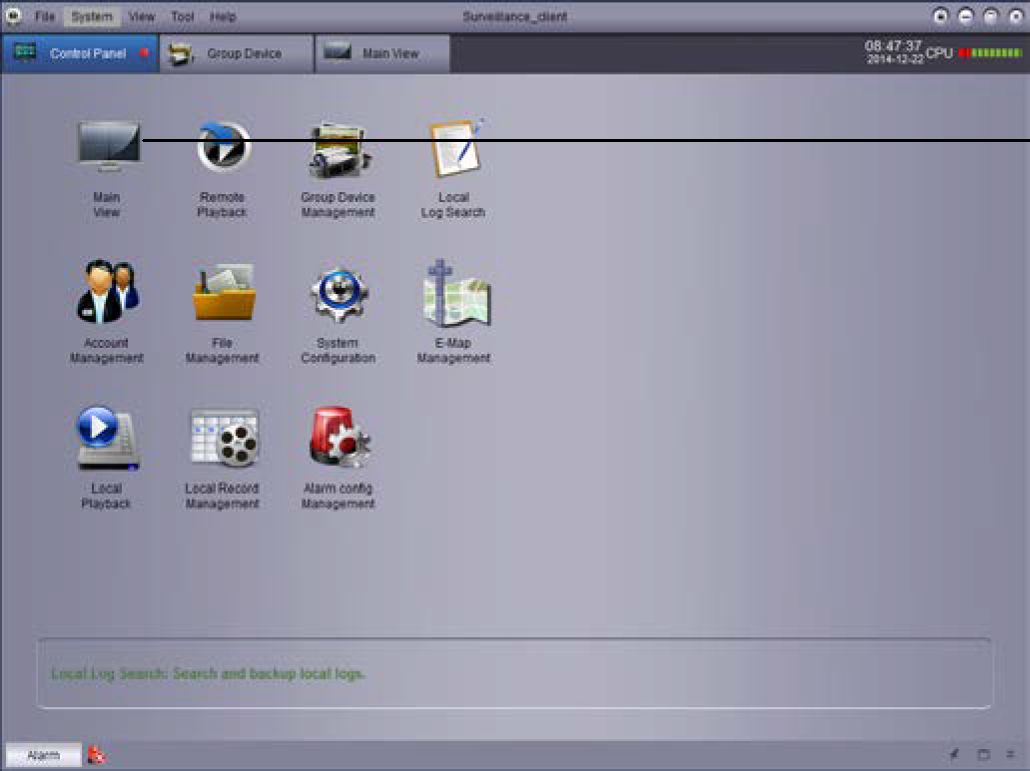
Click Main View.
Fig.5-5
– 13 –
Surveillance-client Software Operation Manual
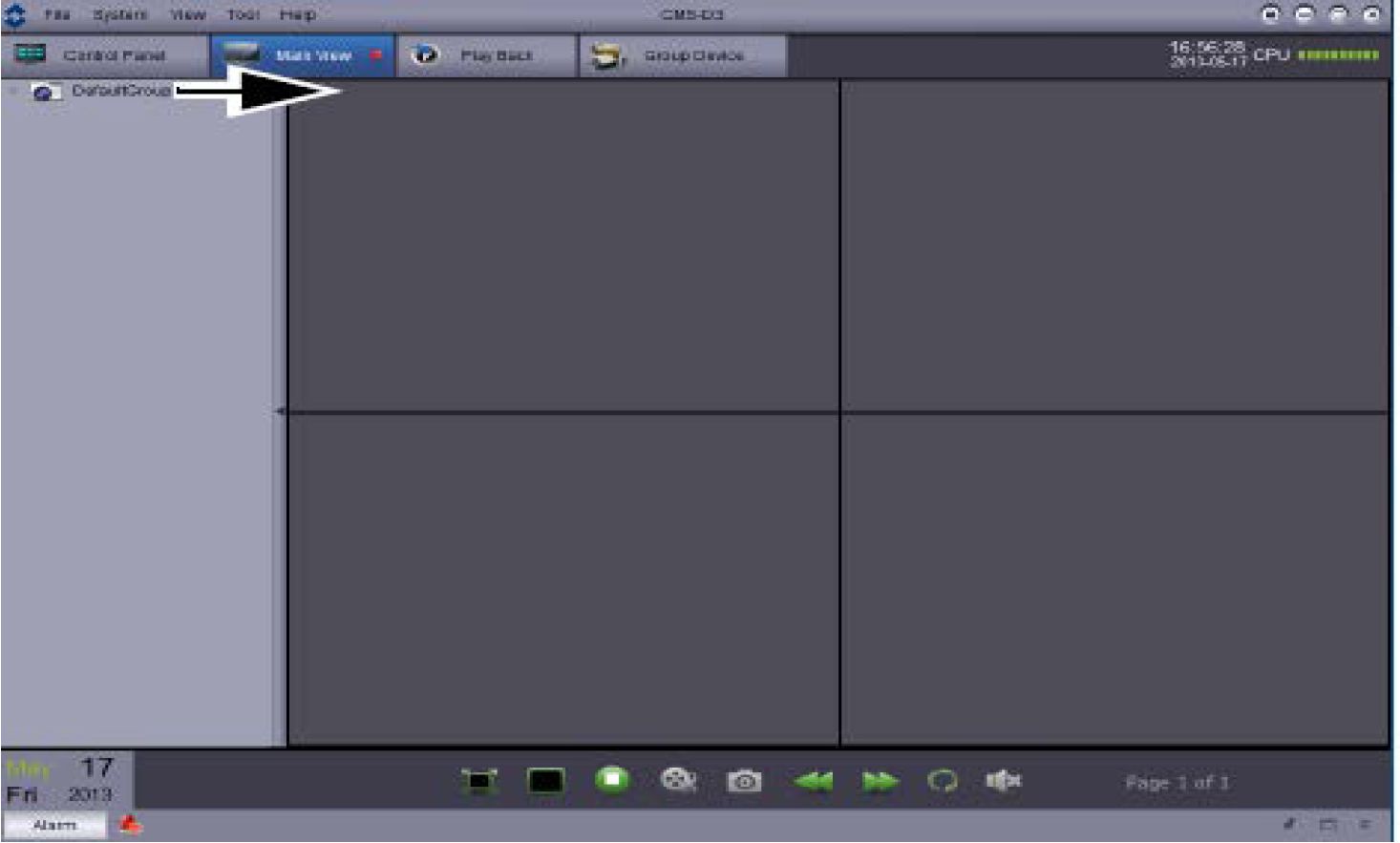
Fig. 5-6
Result
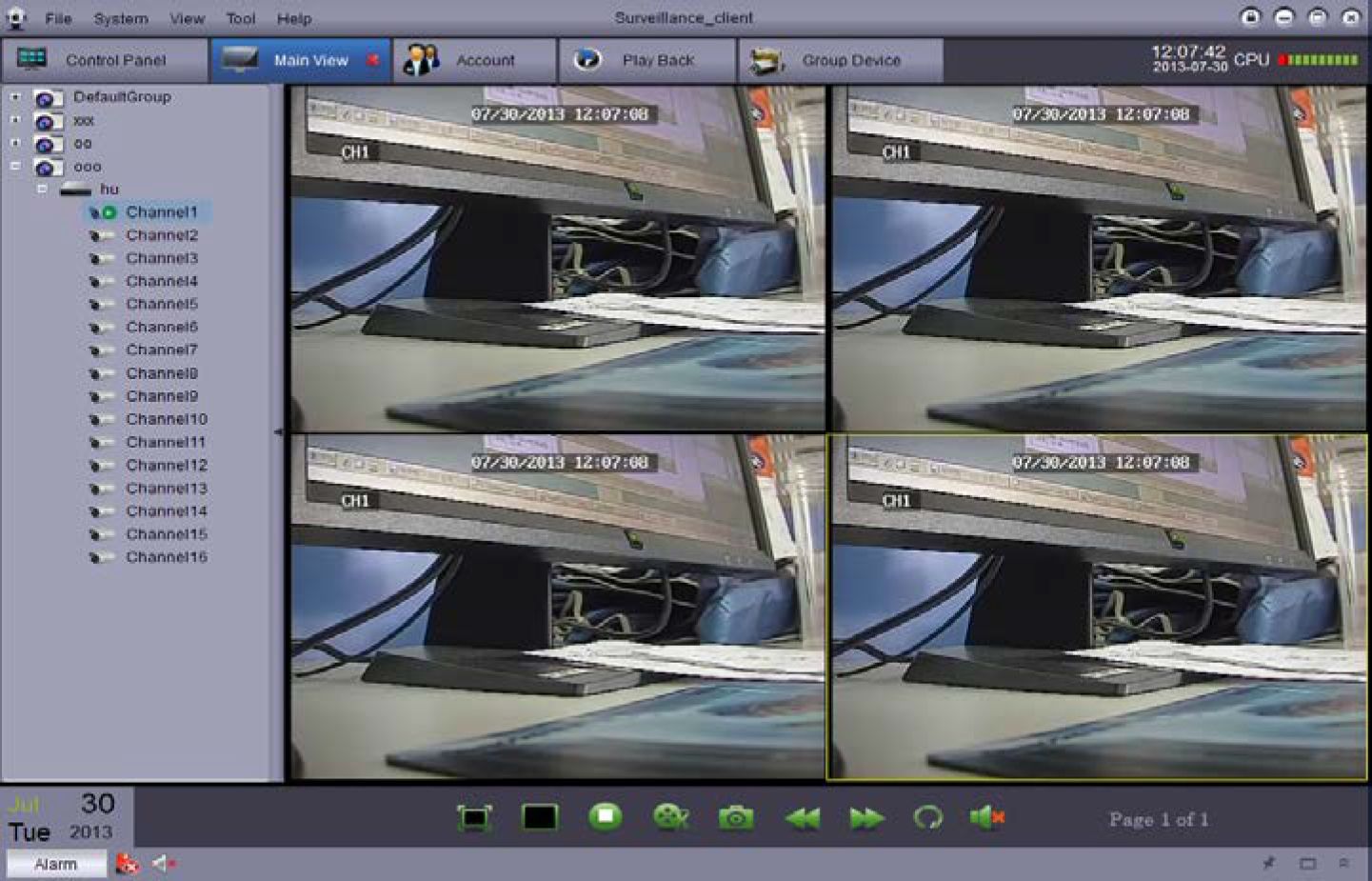
Fig. 5-7
You may access to your DVR through control panel to preview and playback the videos. You can also open control panel and click the control panel option at any time.
– 14 –
Surveillance-client Software Operation Manual
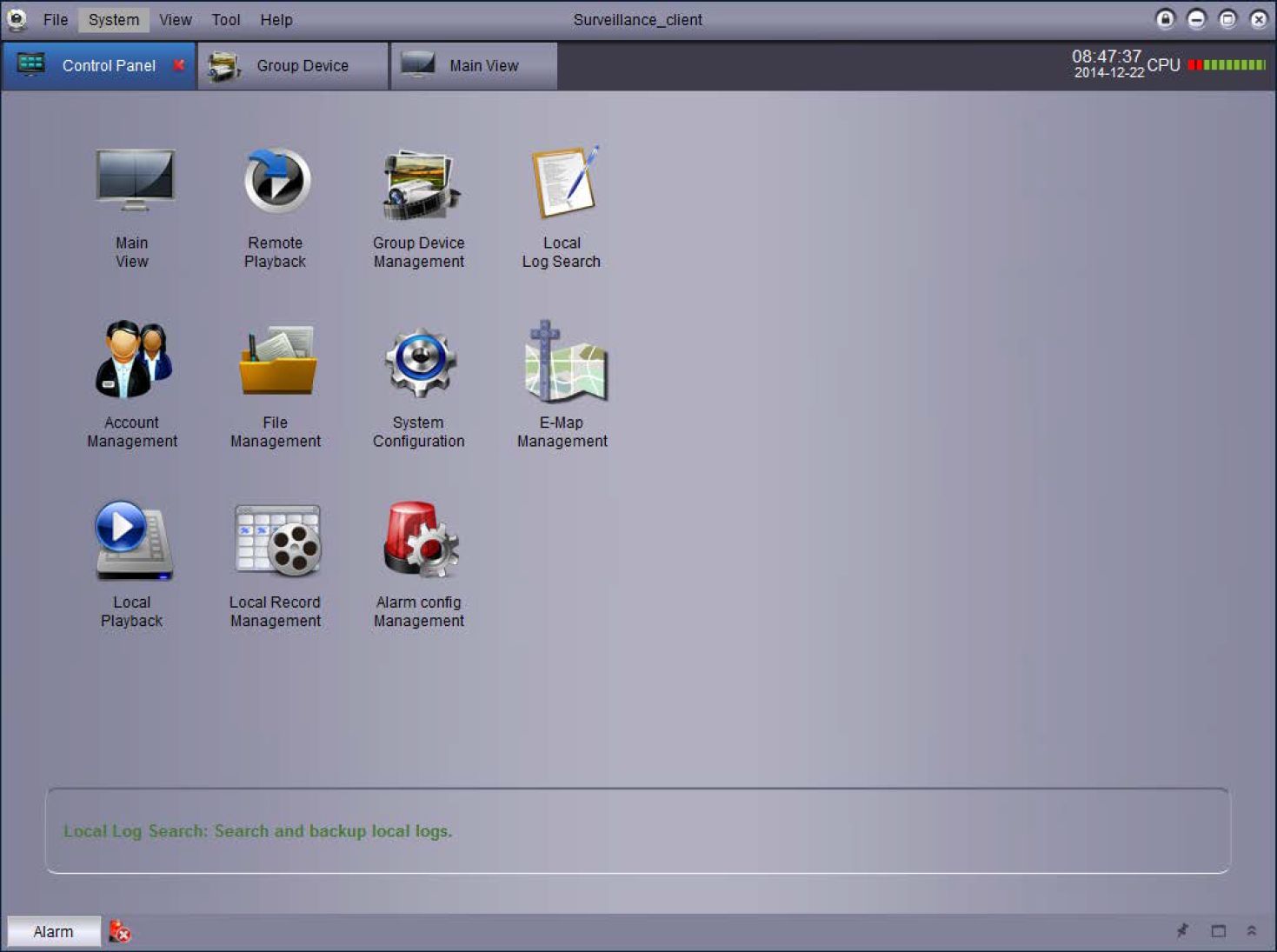
Fig. 5-8
The following options can be found in the Control Panel:
- Main View: Remotely preview the videos. Refer to 5.3 Main View for details.
- Remote Playback: Play the recorded videos in the DVR. Refer 6. Remote Playback for details.
- Group Device Management: Manage DVRs and camera groups. Remotely control the DVR configuration. Refer to Group Device Management for details.
- Local Log Search: Search log of DVR. Refer to Local Log Search for details.
- Account Management: Set up the account and password for the client software. Refer to Account Management for details.
- File Management: View and management the snapshots and recorded files. Refer to File Management for details.
- System Configuration: Configure Surveillance_client. Refer to System Management for details.
User may preview the videos in Main View. To access to Main View, enter Control Panel and
click Main View (

)
– 15 –
Surveillance-client Software Operation Manual
©
®
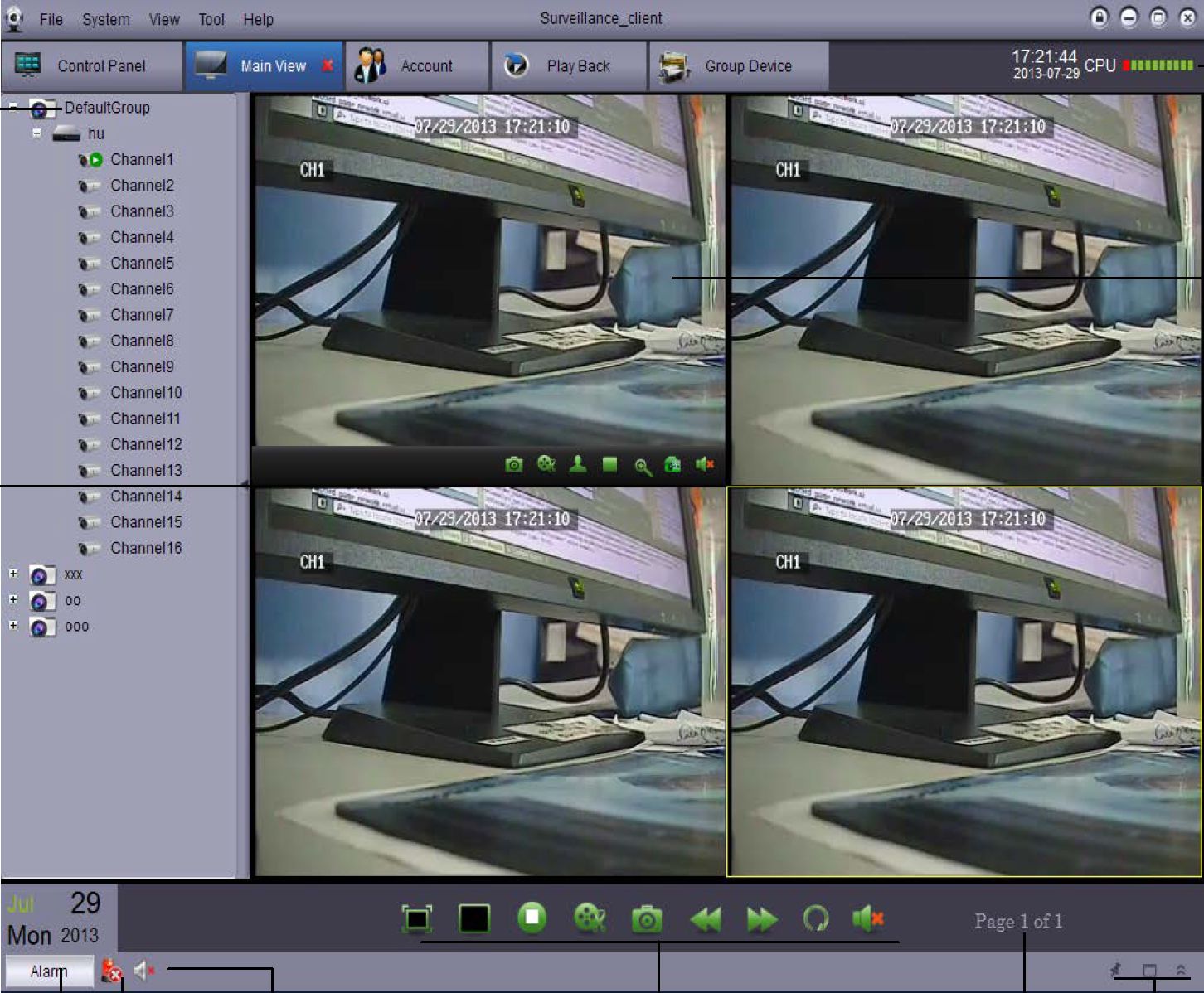
®
®
®
®
® ®
Fig. 5-9
®
®
| 1 | Camera is online |
| w o | Preview the camera video |
| Camera is offline (connection problem) |
• Click and drag the camera, camera group or show grid to open.
Tip: You may click and drag the camera and create customized view from different DVRs.
- Hide the list of DVR/Camera: Click the arrow to hide/display DVR list.
- Alarms: Click alarm panel and the system alarm list and events, e.g. motion detection event, will be displayed on the screen.
– 16 –
Surveillance-client Software Operation Manual
Alarm MB!
| Alarm Tim* | Group Name | DeMce Name | Channel | Alarm Type | Information | * |
| 2013-05-21 14 10 27 | DefaunGroup | DVR | Channels | Motion Detection | Motion Begin | |
| 2013-05- 21 14 10 24 | OefaultGroup | DVR | Channel^ | Motion Detection | Mahon End | |
| 201305-21 14:1024 | DefaunGroup | DVR | Channels | Monon Detection | Motion Ena | |
| 201 >05-21 14.10 05 | Defa uh Group | DVR | Channel? | Motion Detection | Motion Begin | |
| 2013-05-21 14:10:05 | DefaunGroup | DVR | Channels | Motion Detection | Moton seam | |
| p Motion Detection | p] video Eicepiion I | •> Alarm I/O |
Fig. 5-10
Remove alarms

Click to remove all the alarms in the list.
Mute alarming sound

Click to enable mute or cancel mute. Set the alarming sound.
Toolbar of the Main View:

7.
8.
Full screen display Selecting a layout | Stop status display

: Click to enable full screen display and press ESC to exit.
Split screen mode selection key
Click to stop all channel previews.
• Screenshot 0^: Click to save the screenshot of the current channel.
Cut videos
: Click to start/stop cutting currently selected channel video.
: Click to go to previous page or next page.
Previous/Next
Sequence : Click to configure sequence mode.
Audio

: Audio ON/OFF
Page 1 of 3
: When multiple cameras are opened, the screen is split to form multi-screen
Page
display window and many pages are formed. The number of current page and total page is displayed
on the bottom of the screen.
Alarm Control Panel:
•
• •
•
•
•
•
•
•
• Auto-hide: Click to enable/disable the auto-hide function of alarm panel.
Maximize the alarm panel: Maximize the alarm panel in the tab page.
Display/hide alarm panel.
- Camera Display: Select a channel and put the cursor on the toolbar of the channel. The toolbar contains the following options:
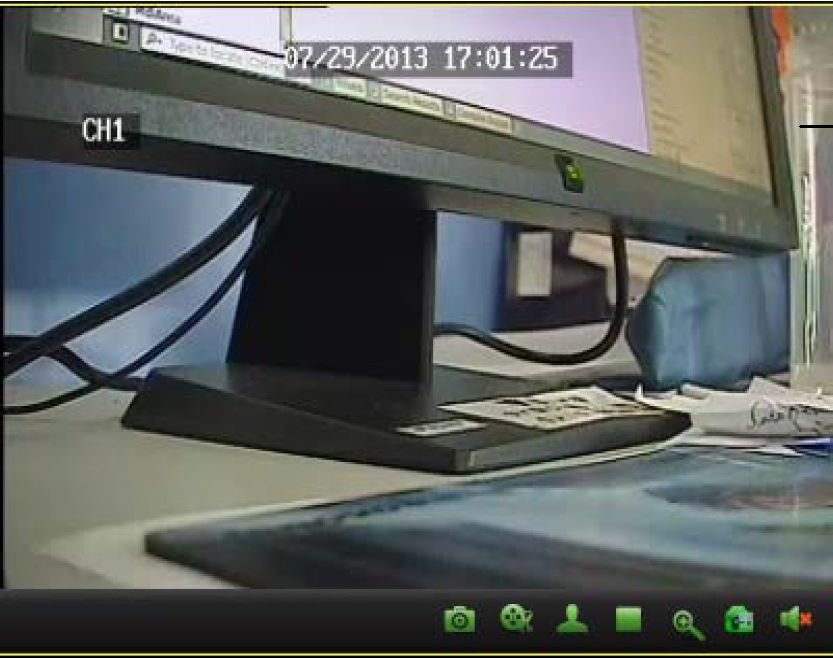
Click a channel to
open toolbar.
Fig. 5-11
– 17 –
Surveillance-client Software Operation Manual
•
•
Cut videos
Screenshot
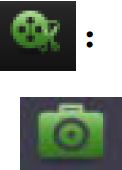
Click to start or stop cutting the currently selected channel video.
: Click to save the screenshot of the current channel.
•
•
•
•
•
PTZ
Click to use PTZ control. Refer to PTZ Control for details.
Stop Video LJ:
Digital Zoom
Color setting

Click to stop the current channel video.
Click to use digital zoom mode.
Open the color setting menu of the current camera.
Mute

: Mute/unmute the current preview video.
Create multiple tab pages of preview video windows. Customize the preview video windows as required (4 tab pages can be opened at most).
Open multiple windows:
– 18 –
Surveillance-client Software Operation Manual
Click preview tab page and drag it out of the main window to create the 2nd display window.
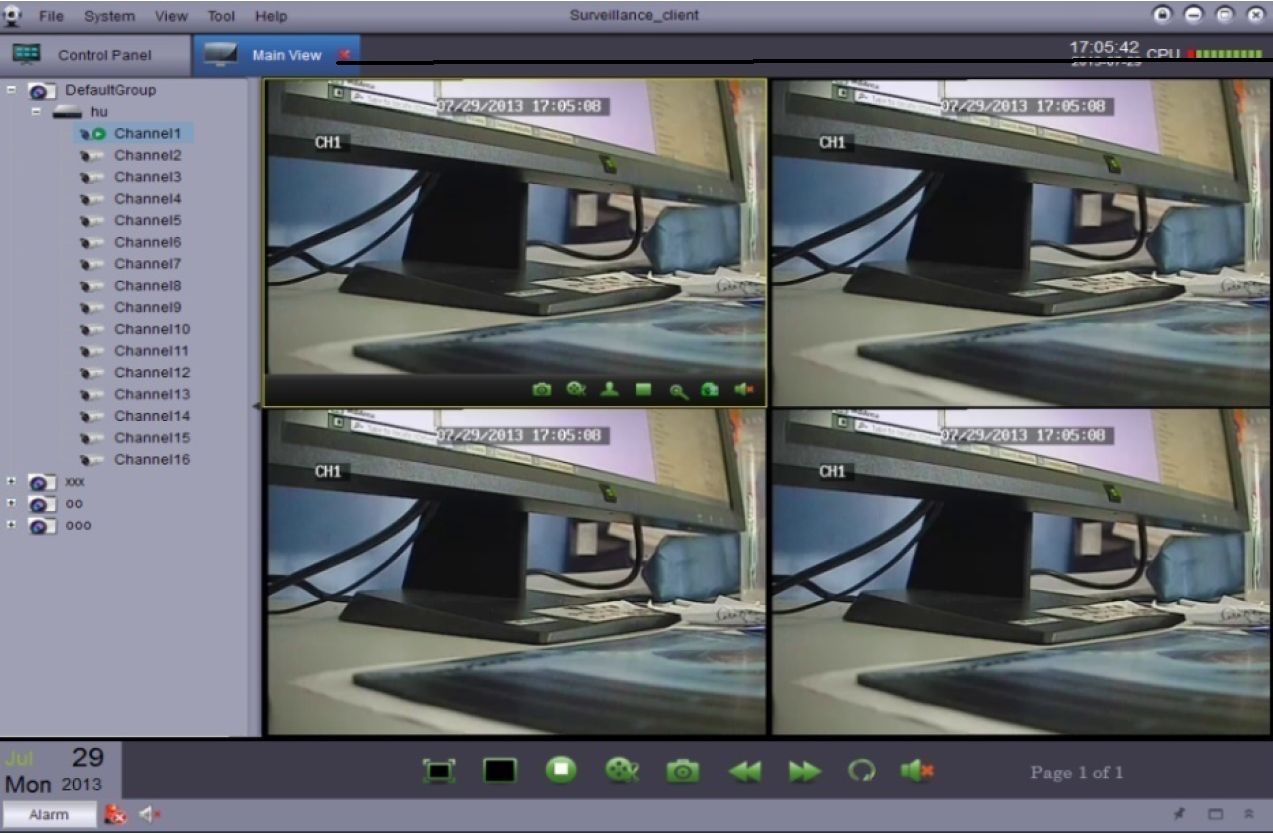
Click and drag it out of the main window.
Fig. 5-11
Result:
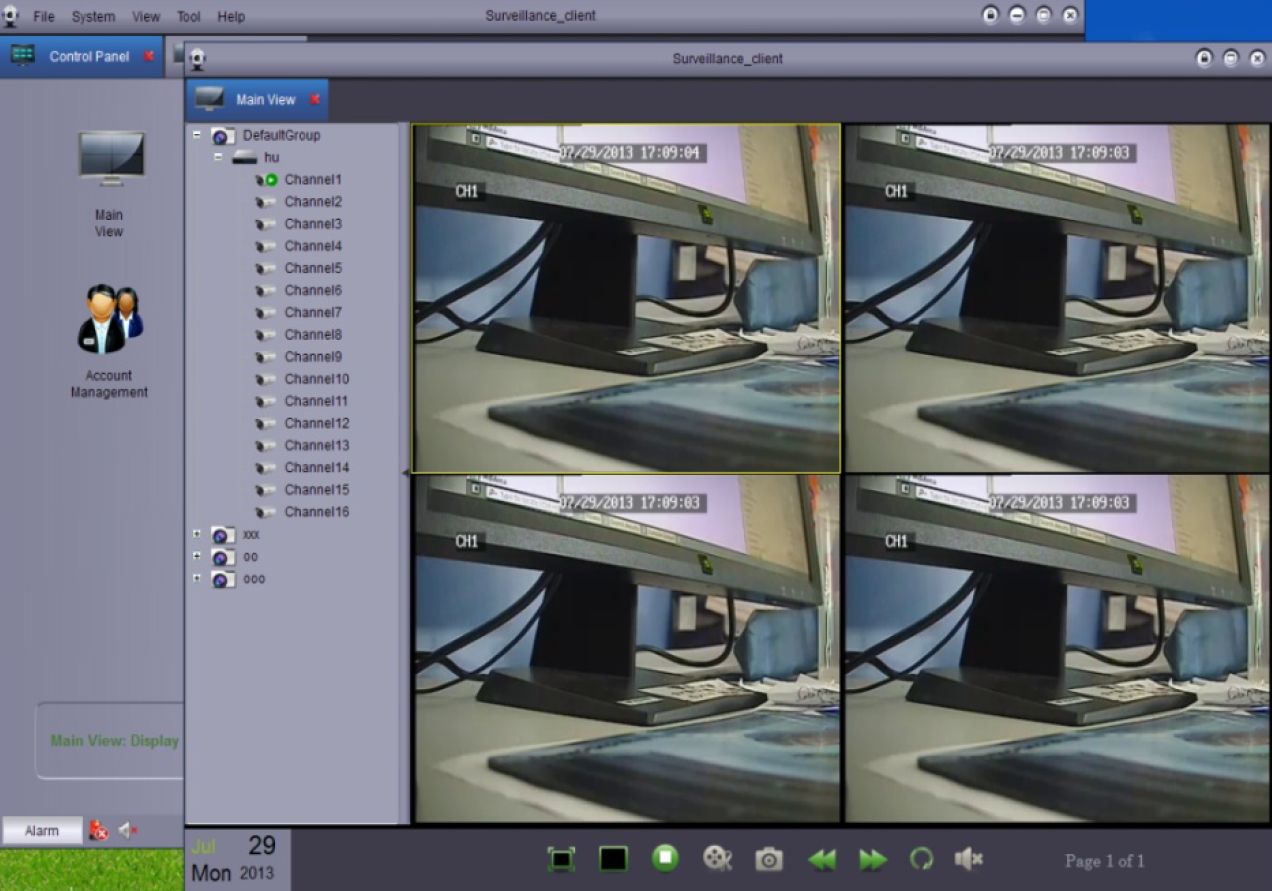
Fig. 5-12
Open multiple
tab pages. You
can monitor
different videos
from multiple
monitors.
When Sequence Mode is enabled, the main view will be in automatic cycle mode in setting time. You may set sequence mode for one or all preview video window.
– 19 –
Surveillance-client Software Operation Manual
Use Sequence Mode:
1.
Click

to enable sequence mode control.
‘Independent’ or ‘Sync With Global’ to perform independent sequence for current window or
synchronize with other windows in the same time interval.
Click ‘Current Main View’ to use Sequence Mode for current window.
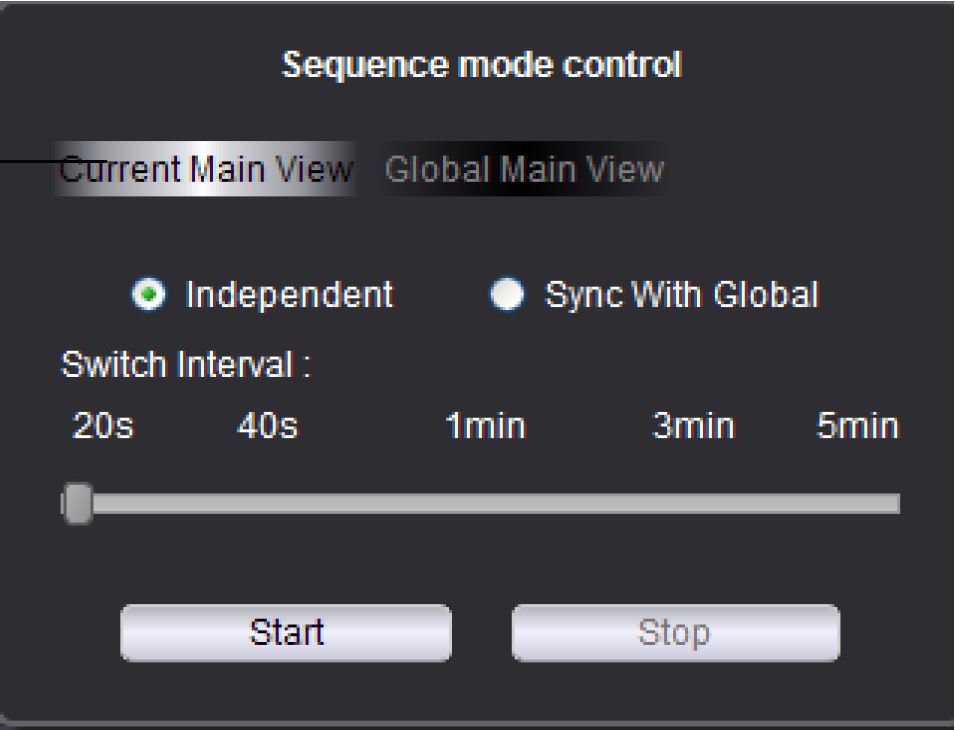
Fig. 5-13
or
If you want to use Sequence Mode in all windows, click ‘Global Main View’. All main view windows which are selected ‘sync with global’ will be in synchronized sequence mode. If ‘Force all main view synchronize with global’ is selected, all main view windows will be forced to sequence in the same time interval.
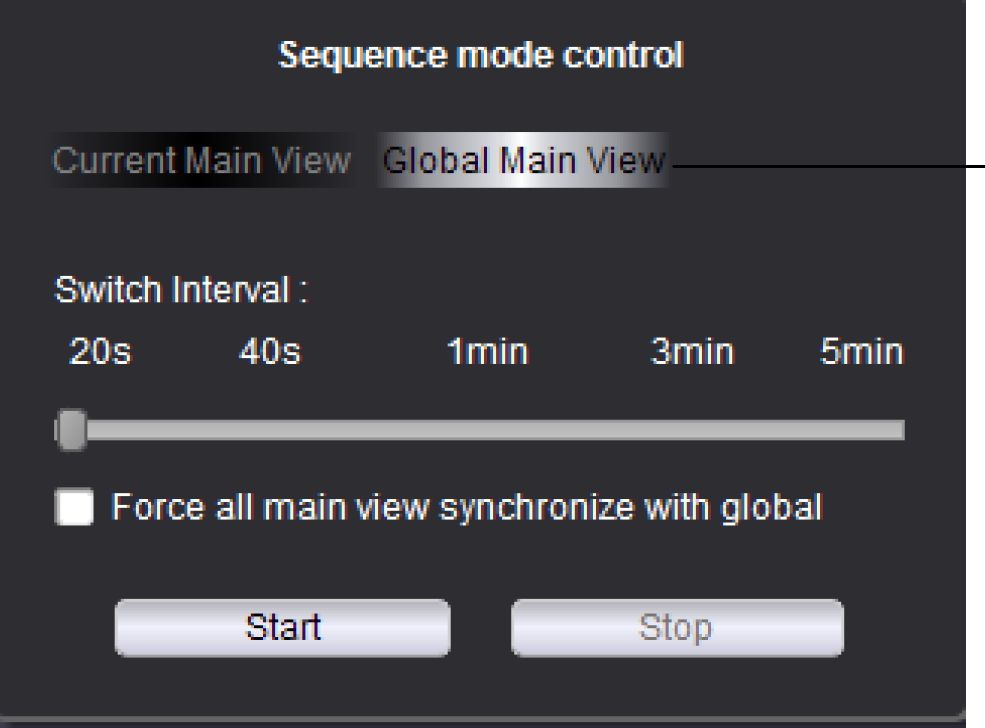
Click ‘Global Main View’ to use Sequence Mode in all windows
Fig. 5-14
– 20 –
Surveillance-client Software Operation Manual
If you have a PTZ camera, you may perform remote control by using software.
Note: Before remote control of PTZ, please make sure the relevant parameters of PTZ hve been set in DVR. Refer to operation manual of DVR for the detailed setting of PTZ.
PTZ Camera Control:
1. In Main View, put cursor on PTZ camera and the toolbar will appear. Click EJ to open PTZ control.
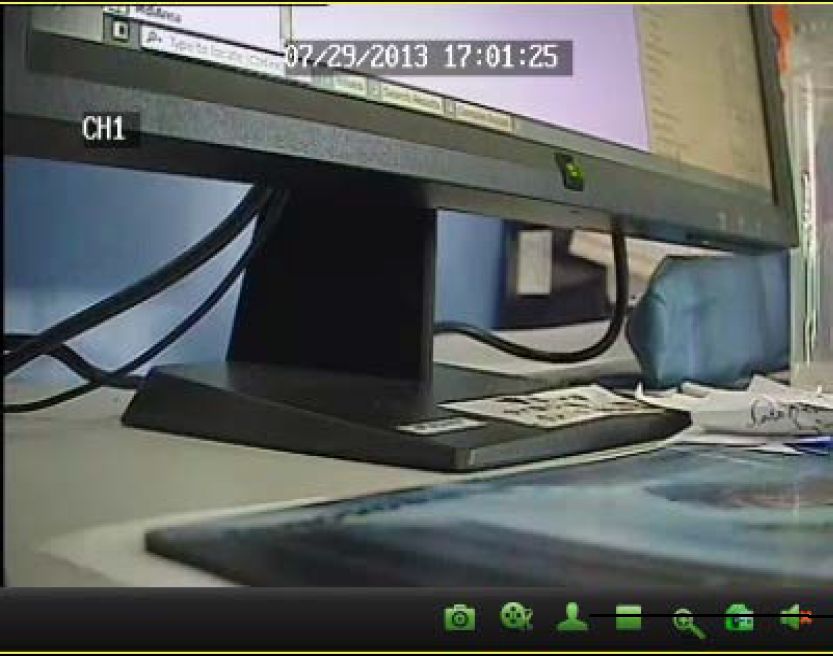
Fig. 5-15
Open PTZ control
PTZ Control
Use cursor to control the position of camera
Adjust PTZ speed
Configure/Call preset point
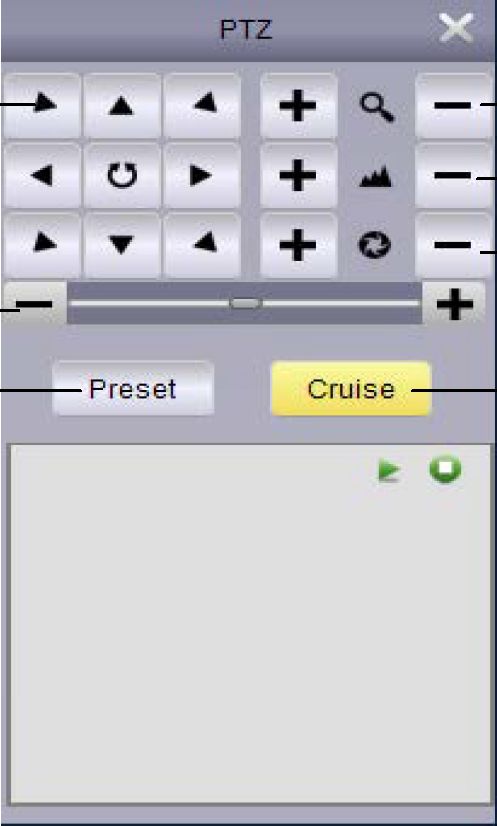
Fig. 5-16
Adjust the zoom
Adjust the focus
Adjust the aperture
Start/Stop PTZ Cruise
– 21 –
Surveillance-client Software Operation Manual
Click to set
Preset point
Select preset number
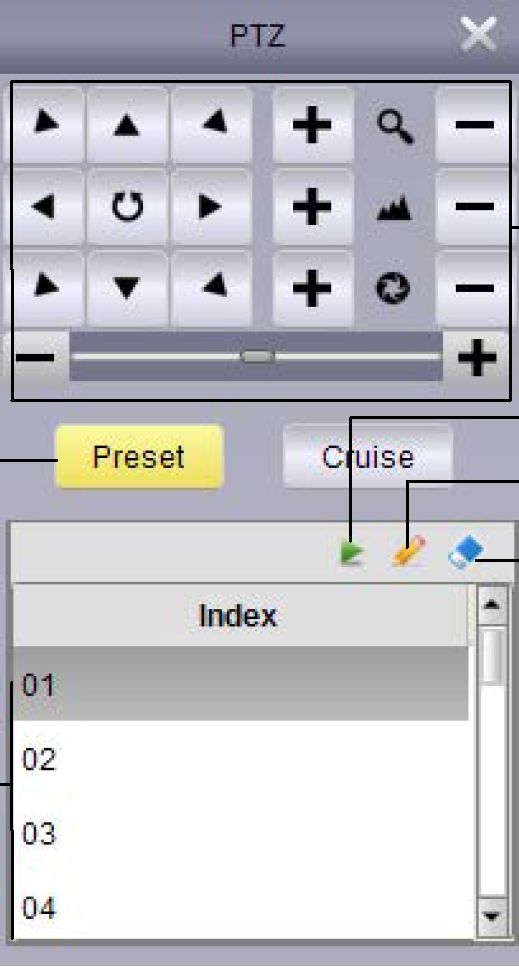
Fig. 5-17
Set PTZ position
Call preset point
Set preset point
Delete preset point
When PTZ cruise is enabled, PTZ will start cruising through saved preset point. Set more than two preset points and cruising can be started.
Start/Stop PTZ cruise.
1. Click Cruise.
2. Click iz to start PTZ cruise and click to stop PTZ cruise.
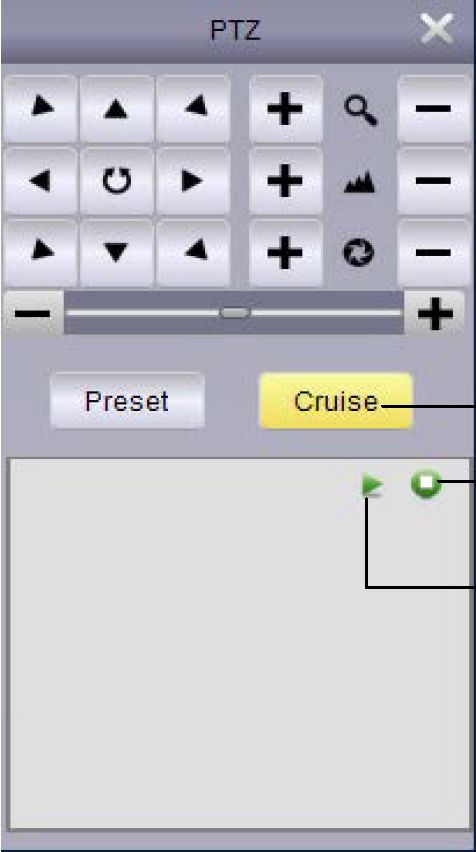
Fig. 5-18
Click to enable cruise control
Click to stop cruising
Click to start cruising
– 22 –
Surveillance-client Software Operation Manual
User can view the audios and videos recorded by DVR in the computer through remote playback.
Remote Playback:

Remote
ri:ta:K
the control panel.
2. Select the video channel for remote playback.
- Playback can be done in 4 channels at the same time.
- Select playback in calendar. The red triangle icon indicates that there is video available for playback.
- Click Search to show the current videos of DVR.
6.
Click r? to play the selected event.
7. Click to select play time in time fence.
Select a camera to play
Select a date in calendar
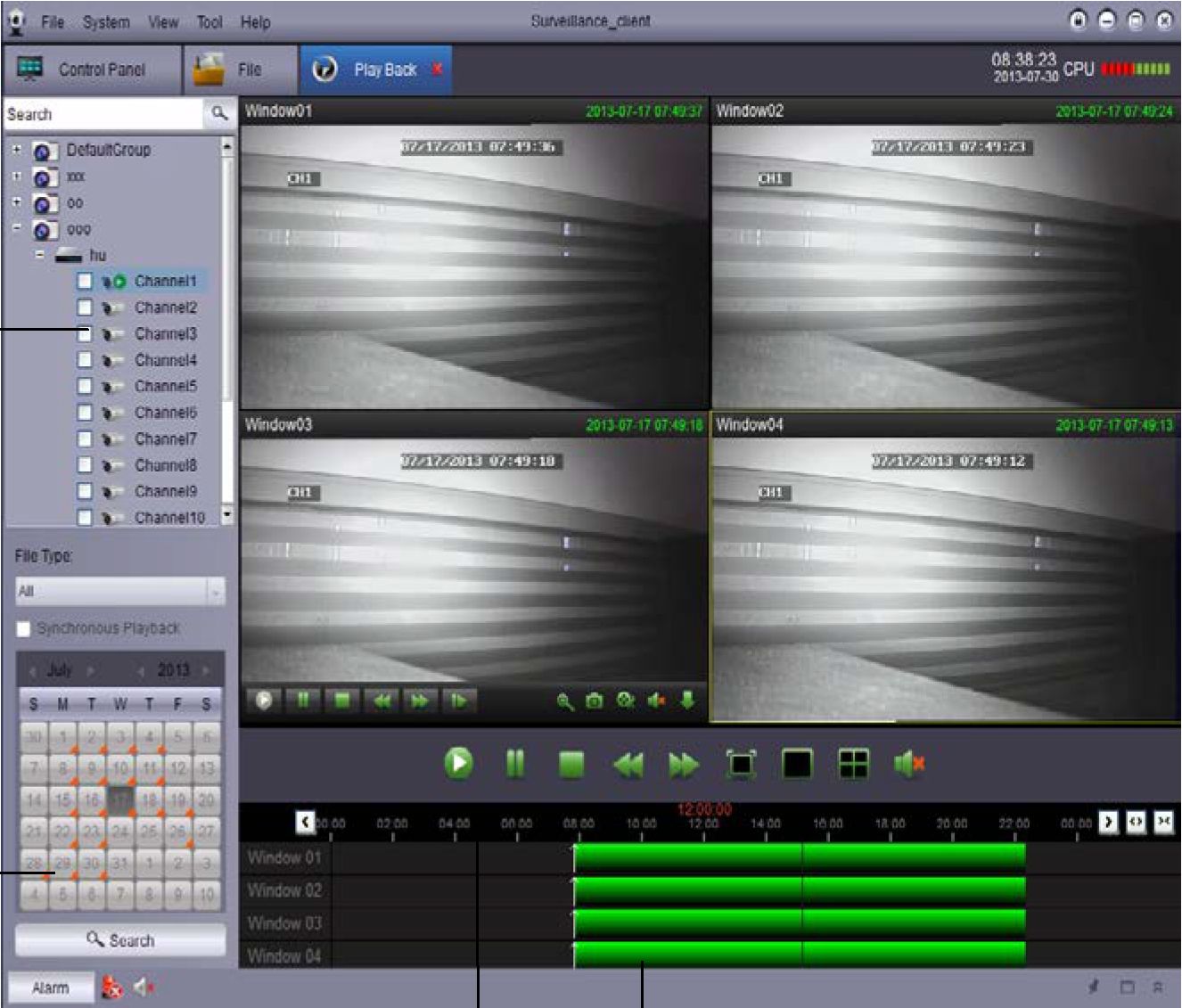
, Click the time fence to select
Click Start to play
play time.
– 23 –
Surveillance-client Software Operation Manual
Select
DVR/Camera
Select Camera
Playback
Select File Type
Enable
SynchronousPlayback
Select Playing Date
Search Video
File System View Tool Help
Search
File Type:
+ Q Default Group
- Q~ »«
- fiLI 00
_ Q 000
- »0 Channell
- « Channel
- ‘♦ Channels
- * ChanneW
- ‘♦ Channels
- ‘• Channels
- ‘• Channel?
- ‘• Channels
- r« Channels
- « ChanneHÖ
Window 01
10:00 12:00 14:00 16 00 10:00 20:00 22:00 00:00 OSE
Move to
Previous period
the right
Click to select playing time
Amplify time
Download

Zoom in/out
Narrow time period
Screenshot
Mute
Cut video
Mute
– 24 –
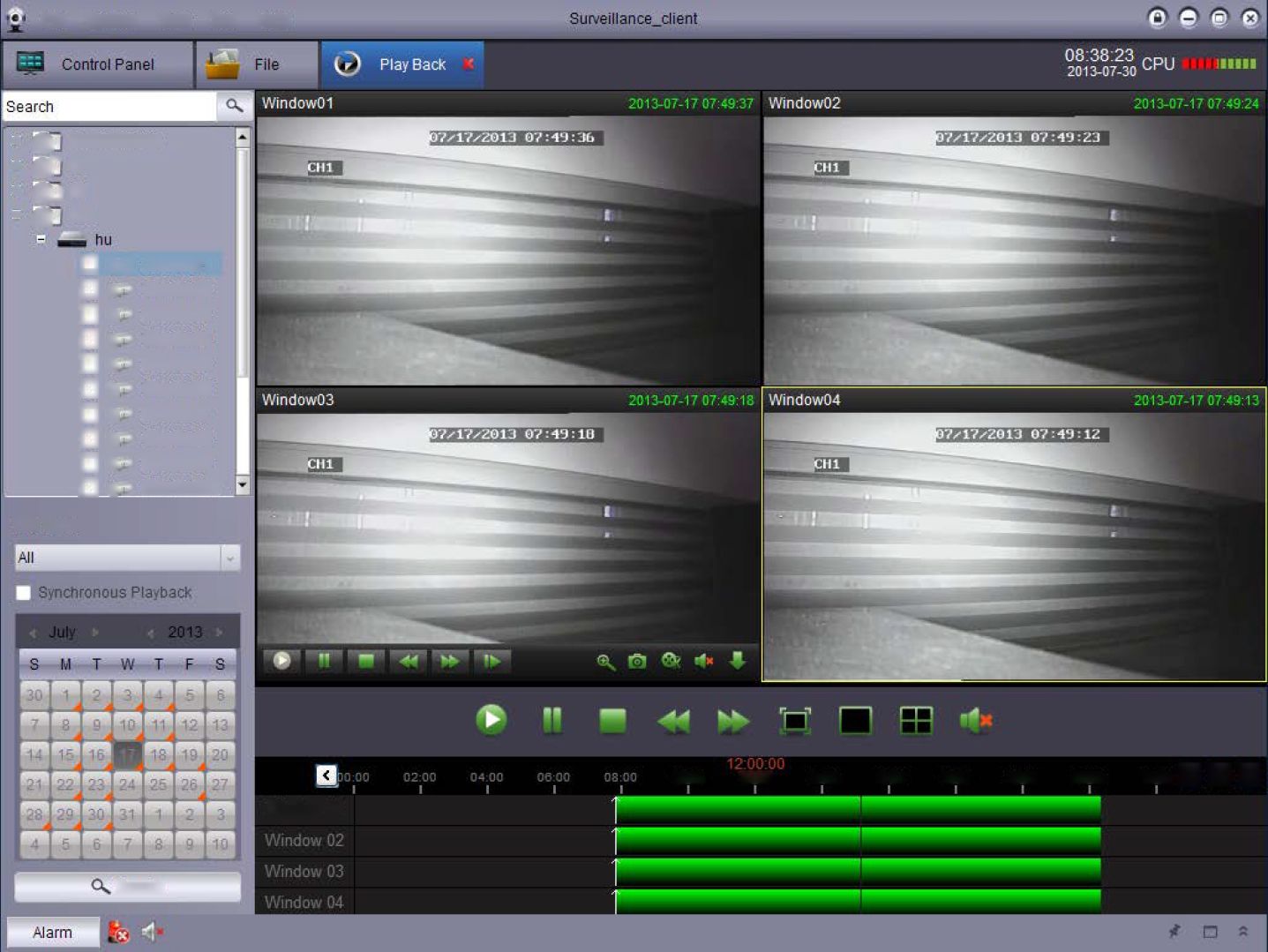
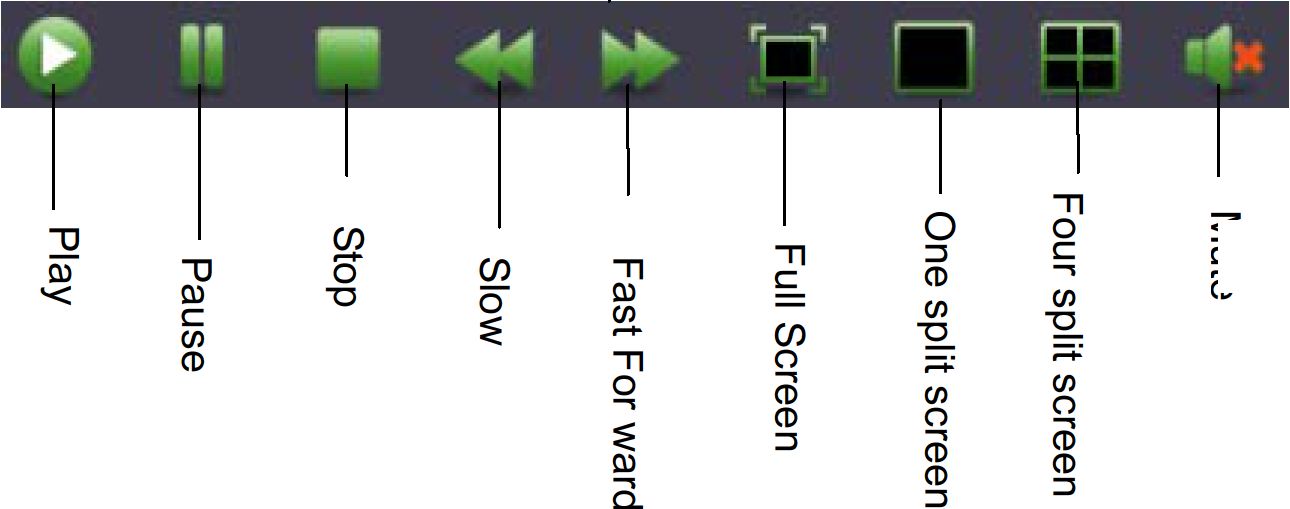
Surveillance-client Software Operation Manual
DVR video files can be remotely downloaded.
Download video files:
1.

to open download menu.
Put cursor on
the video and click
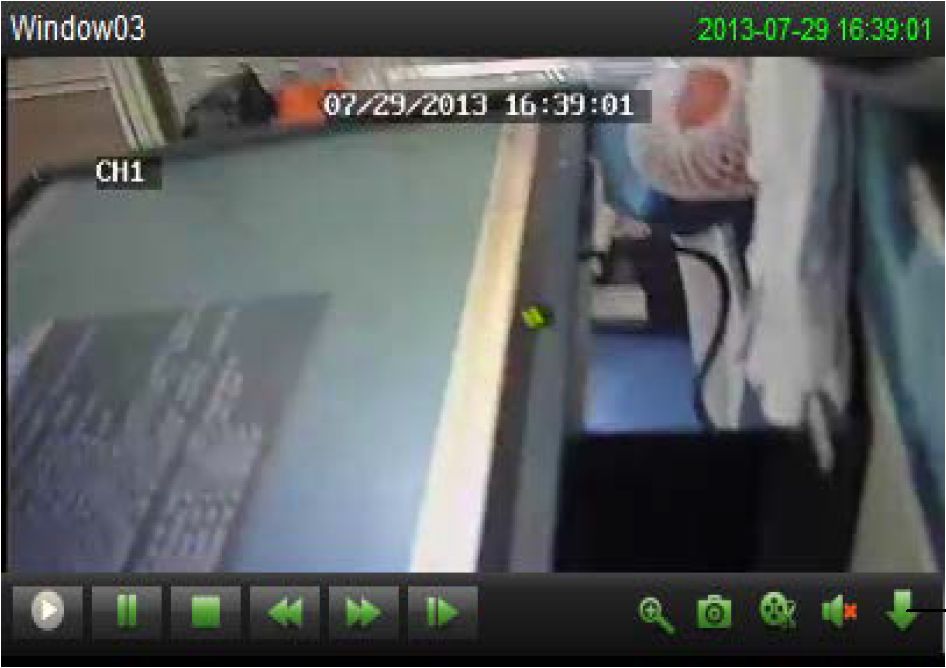
Click to open the download menu.
Video Files
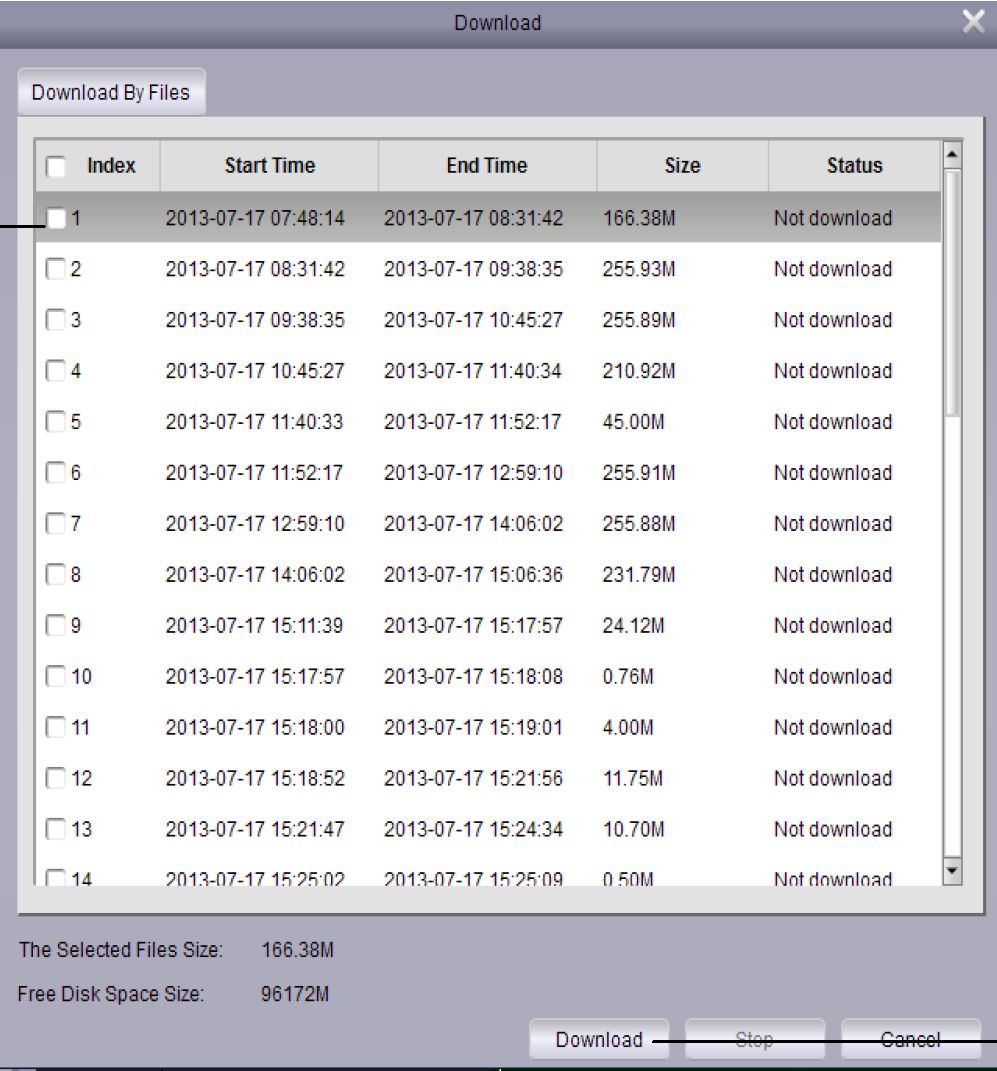
Click to download
– 25 –
Surveillance-client Software Operation Manual
Video file format is .264. Video player is internally installed in Surveillance_client. If you want to convert .264 to AVI, please use AVIGenerator on the attached CD.
Group Device Management Menu is used for managing DVR and camera group.
The device panel on the left allows you to add, modify and delete DVR system and remotely control DVR device. You can set up camera group by the group panel on the right. Import the channels from device panel into group panel to access the videos or playback. You can select different channels from multiple devices to a group. The defaultgroup is created by default. You may create new group as required.
Manually add DVR DVR
Camera
Scan DVR in LAN
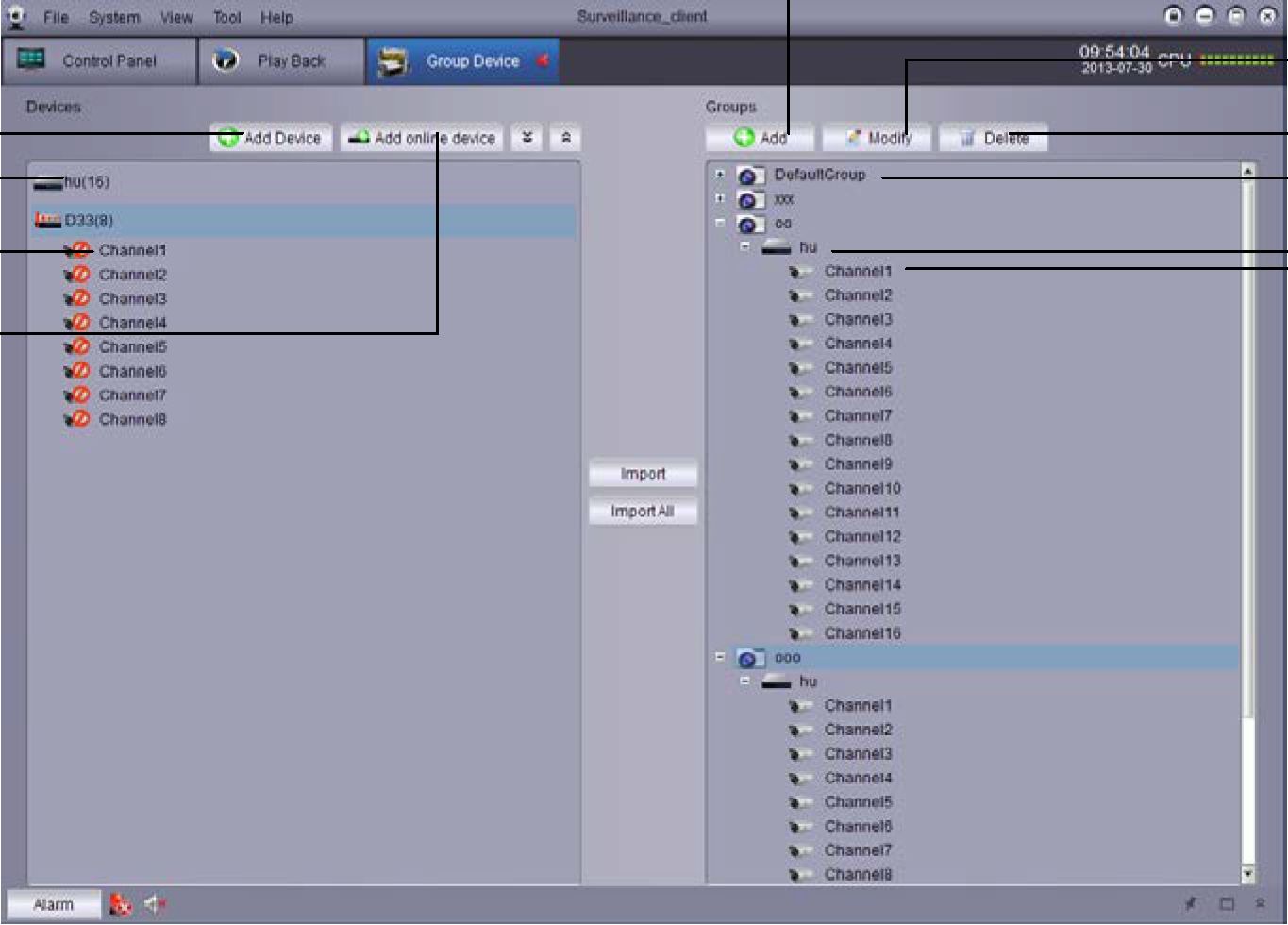
Camera
Add group
Modify group
Delete group
Camera group
– DVR
User can modify the name of DVR and delete DVR or camera from group.
Modify DVR information:
– 26 –
Surveillance-client Software Operation Manual

2. Modify DVR information and save.
Click to select DVR
You may delete DVR from Surveillance_client.
Delete DVR:
and save to delete DVR.
Click to select DVR to be deleted and then click -‘:l

Click DVR to be deleted
You may remotely configure DVR parameters by software.
Remotely configure DVR:
to set parameters. Refer operation manual for details.
• Click

Click to configure the parameters of DVR.
1. Click Add. Input a customized name and then click Yes to confirm.

Click Add
– 27 –
Surveillance-client Software Operation Manual
the selected group.
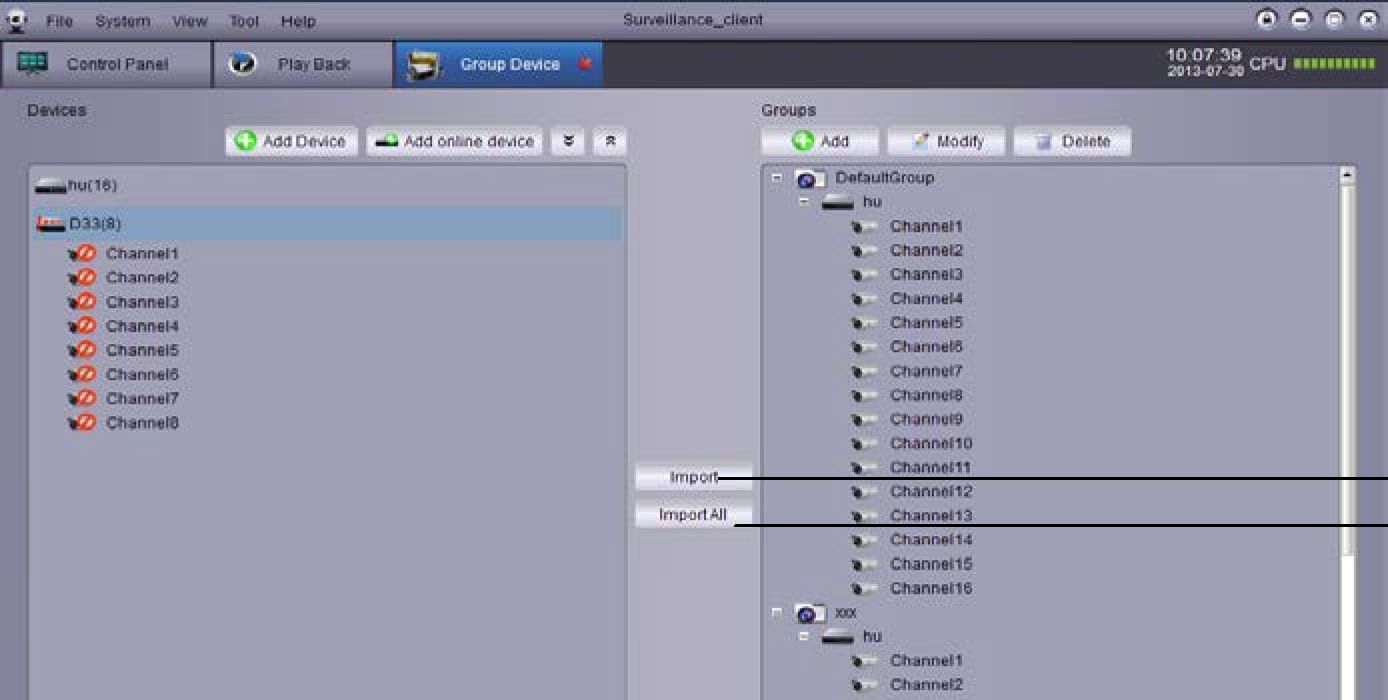
— Import the selected camera
Import all channels of
DVR into group.
Modify group name/Delete DVR or camera from group.
clicking Yes.

Click Modify
Click Group
save by clicking Yes.

Click camera or DVR
Click Modify
– 28 –
Surveillance-client Software Operation Manual
Delete the name of Group/DVR/Camera

Click Delete
Click camera group
• Click camera group and click Delete. Click Yes to confirm.
‘Local Log Search’ refers to searching the log of Surveillance_client. Defaultly it can search one week’s log. User may define the log reservation time as one month. Refer to system setting for details.
Search log:
1. Click Local Log Search

on the Control Panel.
- User Name: Select ‘All Users’ to search logs created by all users, or select ‘Specific User’ to view his log.
- Log Type: Alarm log records motion detection alarms and system alarms. Operation log records configuration change or access of system users to log system (such as login and logout)
- All Type: Select to search logs of all type or specific type.
- Group: Select DVR or Camera group to search desired logs or select All Groups to search logs of all DVRs and camera groups.
- Start Time/End Time: Select start time or end time of searching.
– 29 –
Surveillance-client Software Operation Manual
Set searching parameters
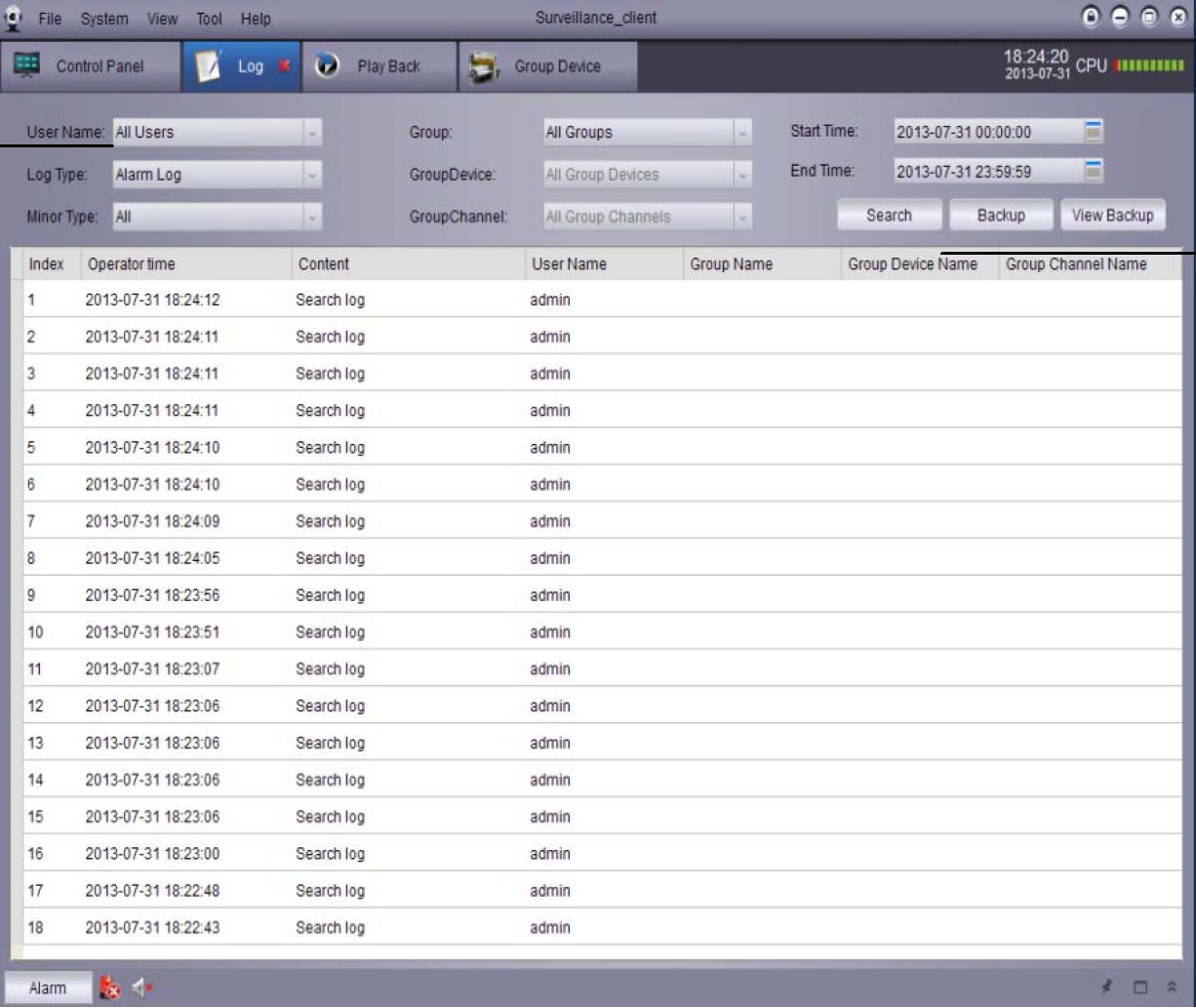
Click Search
User can back up the log search result in the hard disk or view backup log.
Backup log:
2. Click Backup

Click Backup
3.Select a folder and input a file name and then click Save.
Open saved log file:
– 30 –
Surveillance-client Software Operation Manual
1. Click to view backup.

Click to view
Backup and open saved log files.
User may use Account Management menu to create Surveillance_client user account.
The client software includes the following user types:
- Admin: When you firstly run the client software, the default account is admin. The administrator has the privilege to operate client software and remotely configure DVR parameters. The administrator can add, modify or delete any other user accounts.
- User: It is standard user account. User’s privileges are assigned by administrator. User cannot change software setting or change other user account. User can change his own password.
Visit Account Management:
Click Account Management

on the Control Panel.
The password for admin account is blank by default. No password input is needed to log in Surveillance_client. If password is set for admin account, operator has to input password to log in the client.
Create password for admin account.
– 31 –
Surveillance-client Software Operation Manual
Click User Name
Click Modify

Note: Click fij to lock Surveillance_client and user should input password for administrator. Or the user can click System > Change user to user other user account to login. Please note that admin account does not logout until another account login.
Note: Only administrator is allowed to create new user account.
Click Add

- Input password for user account and repeat inputting to confirm.
- Select privileges for the user account on the bottom area.
– 32 –
Surveillance-client Software Operation Manual
Set User Type and Password
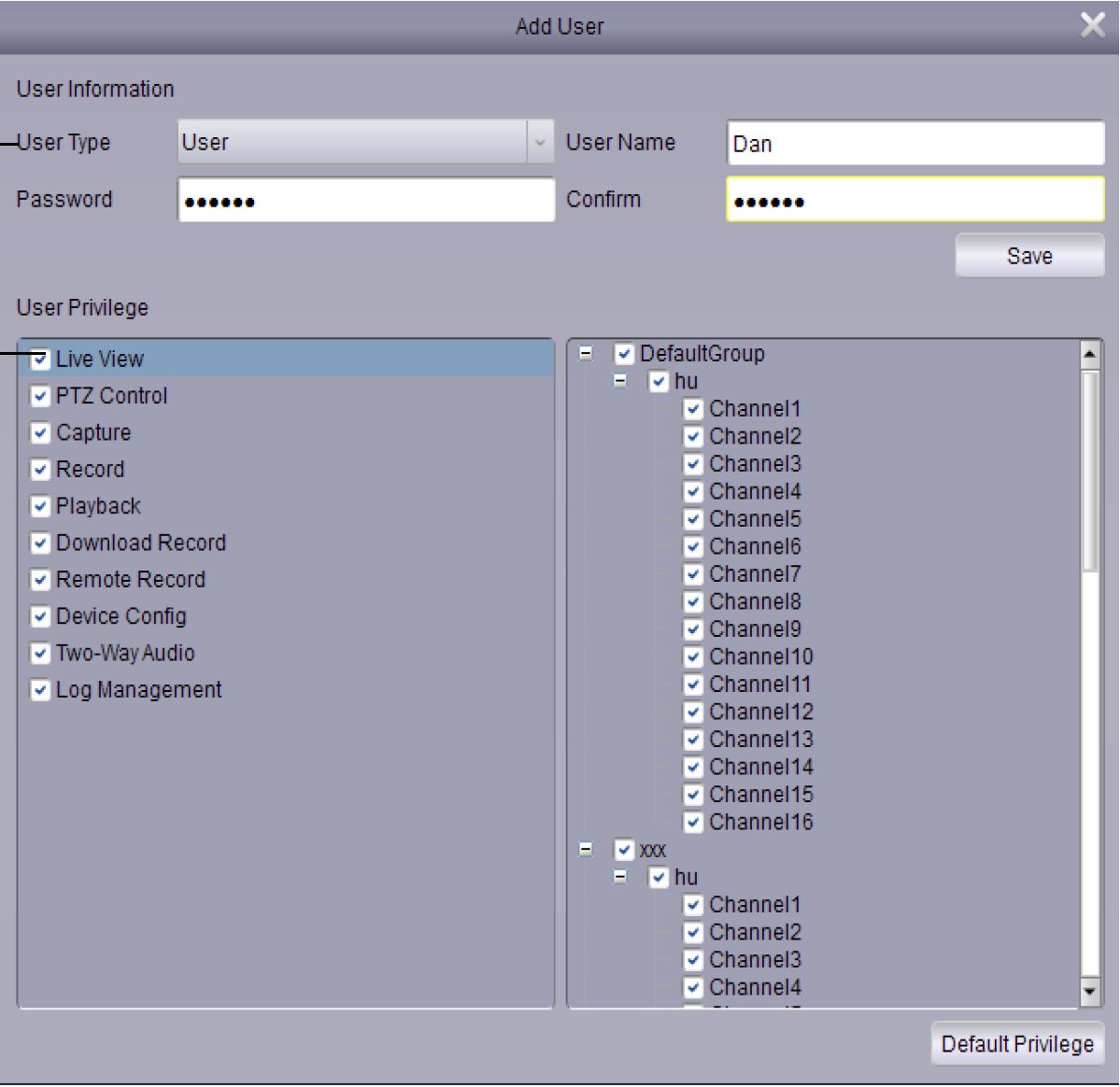
Select user Privilege
- Click Save to create user account.
- Modify User Account
- Click the account to be modified and click Modify.
Click user
Click Modify

Note: Common users can only modify his own password while administrator can modify the password or privileges of any user.
– 33 –
Surveillance-client Software Operation Manual
• Click user you want to delete and click Delete and click Yes to confirm.

Note: Only administrator can delete common user.
Use file management to view local videos and screenshots.
Use file management:
1. Click file management

on the Control Panel.
- Select the camera or DVR you want to search on the left of the screen.
- Click Video to search manual videos or click Picture to search screenshot.
- Set start time and end time. Time period for cutting videos and pictures is for recording original videos, not for saving files.
- Click to search files.
- Double click to open files or use button on the bottom of the screen to delete or save files in your computer.
– 34 –
Surveillance-client Software Operation Manual
Select Picture or Video
Set Start Time and End Time
Select camera group, DVR or camera.
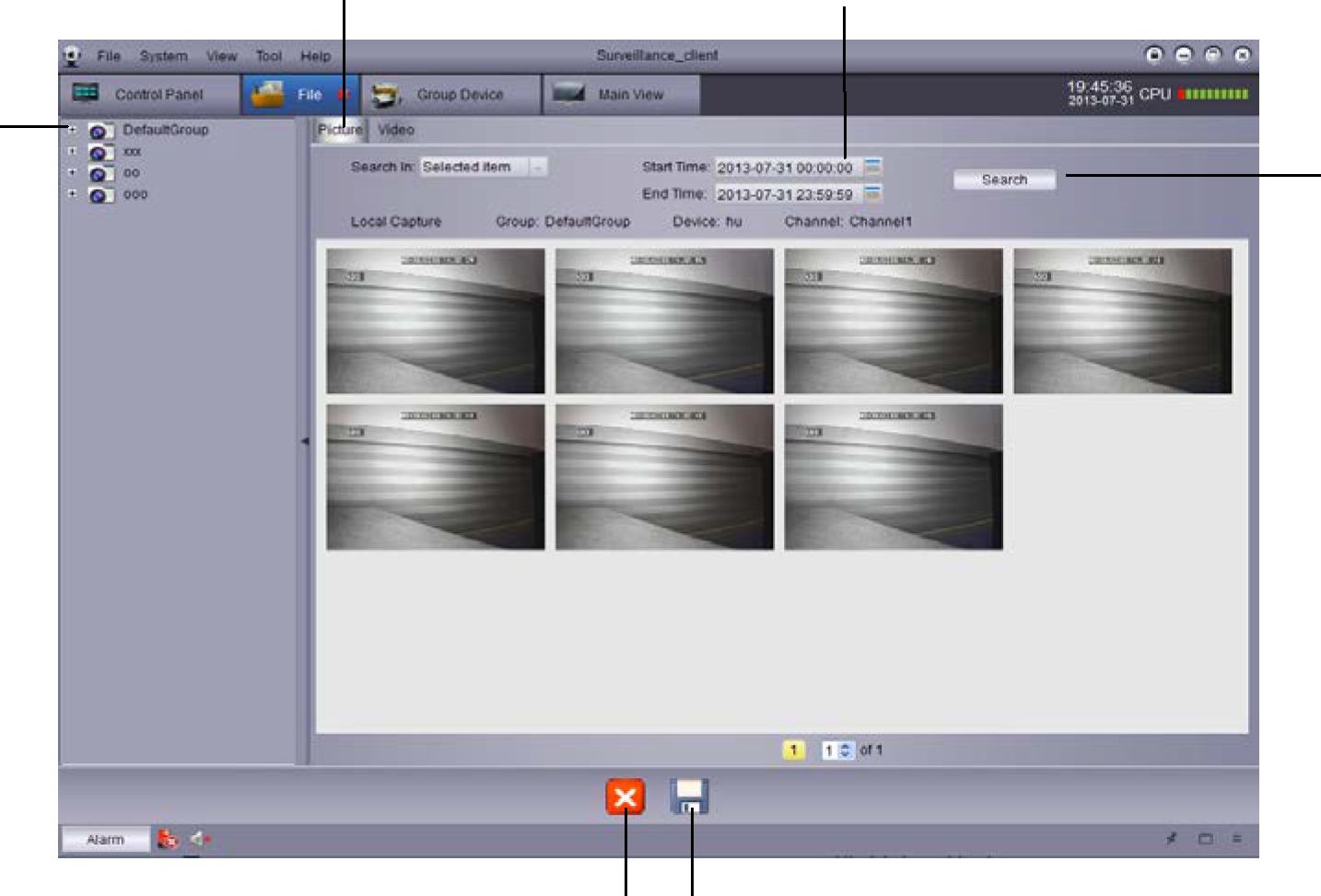
Search file
Delete file
Click to save file in a different location.
Video player can play downloaded files/ cut videos/ local video files.
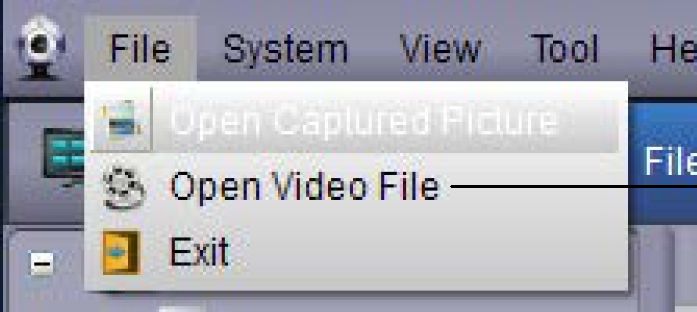
Click File>Open Video File
– 35 –
Surveillance-client Software Operation Manual
2. Click

and select the video file and click Open to play the video file.
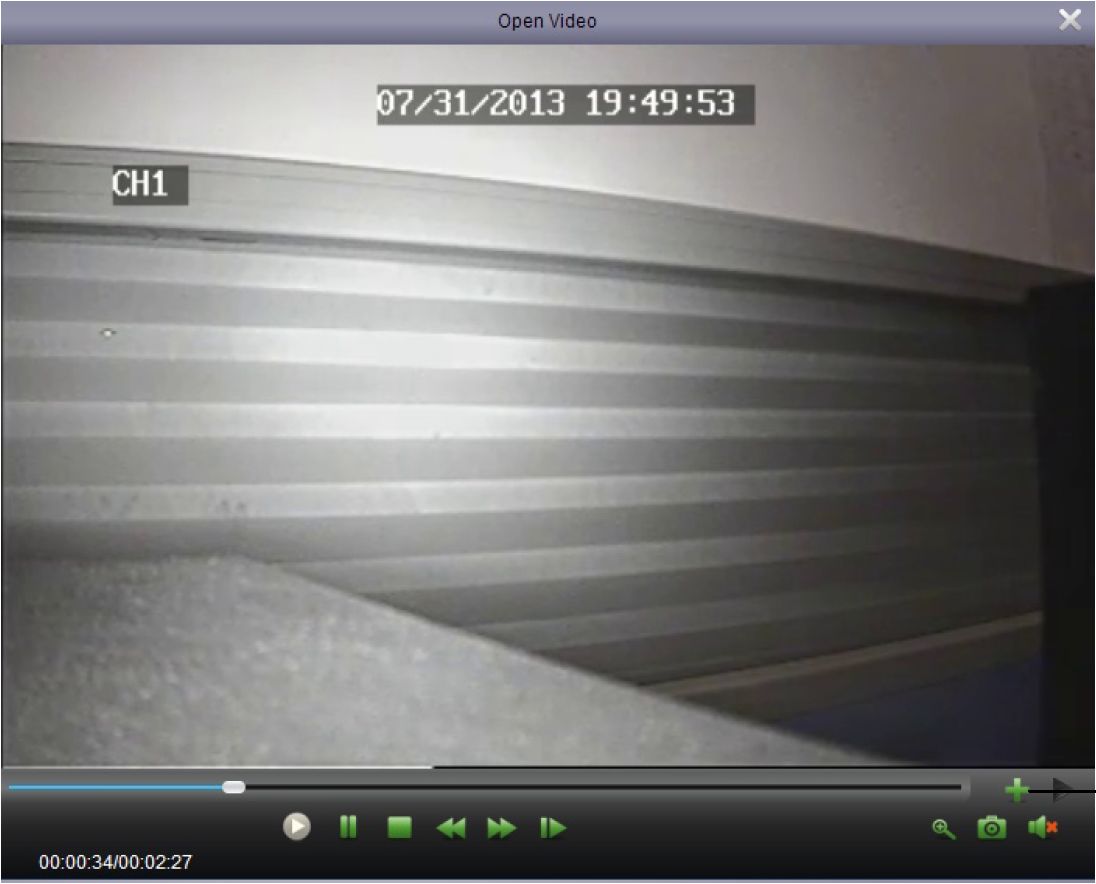
Click to open a video file.
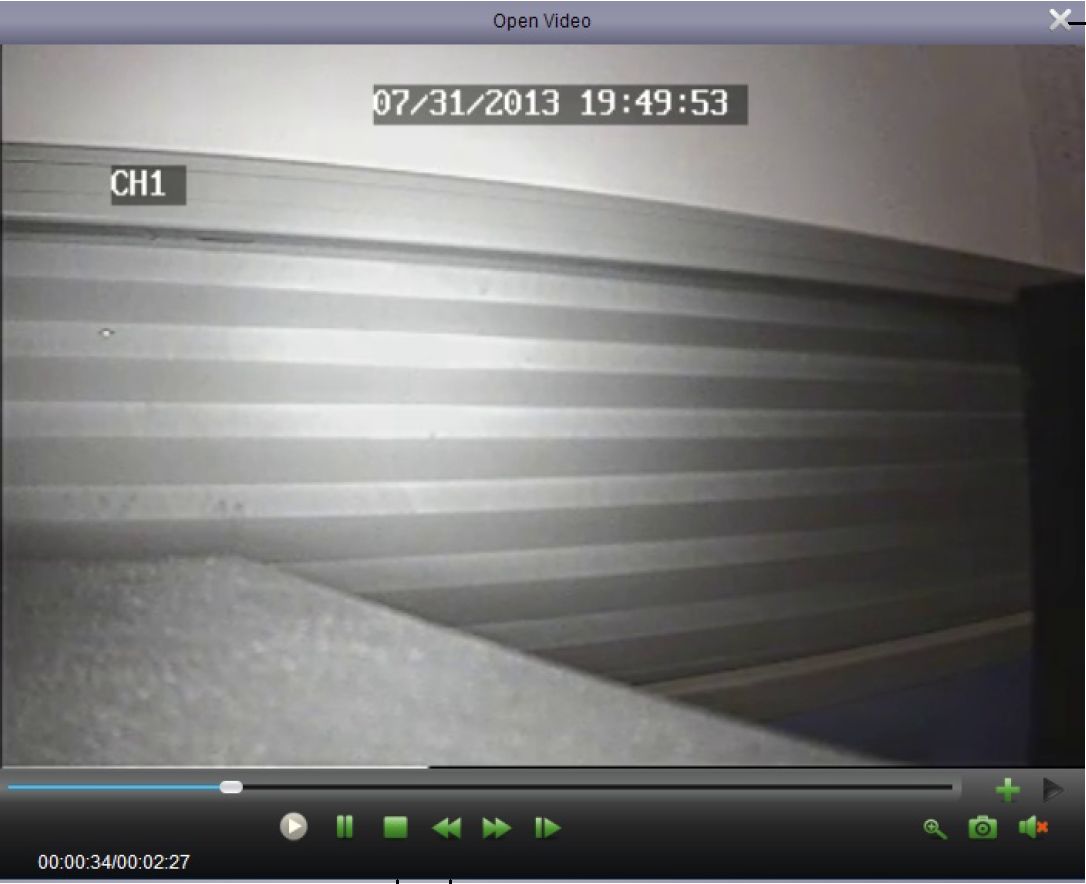
Stop
Play by frame
Close
Mute On/Off
Play
Screenshot
Fast Forward
Zoom in/out
Pause
Fast Backward
Zoom in: click
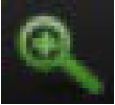
•
and then click and drag on the picture, and click again to zoom in.
– 36 –
Surveillance-client Software Operation Manual
System configuration is used for configuring Surveillance_client.
System configuration:
• Click system configuration
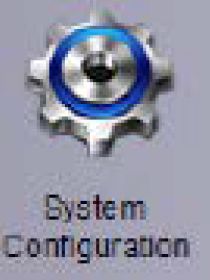
on the Control Panel.
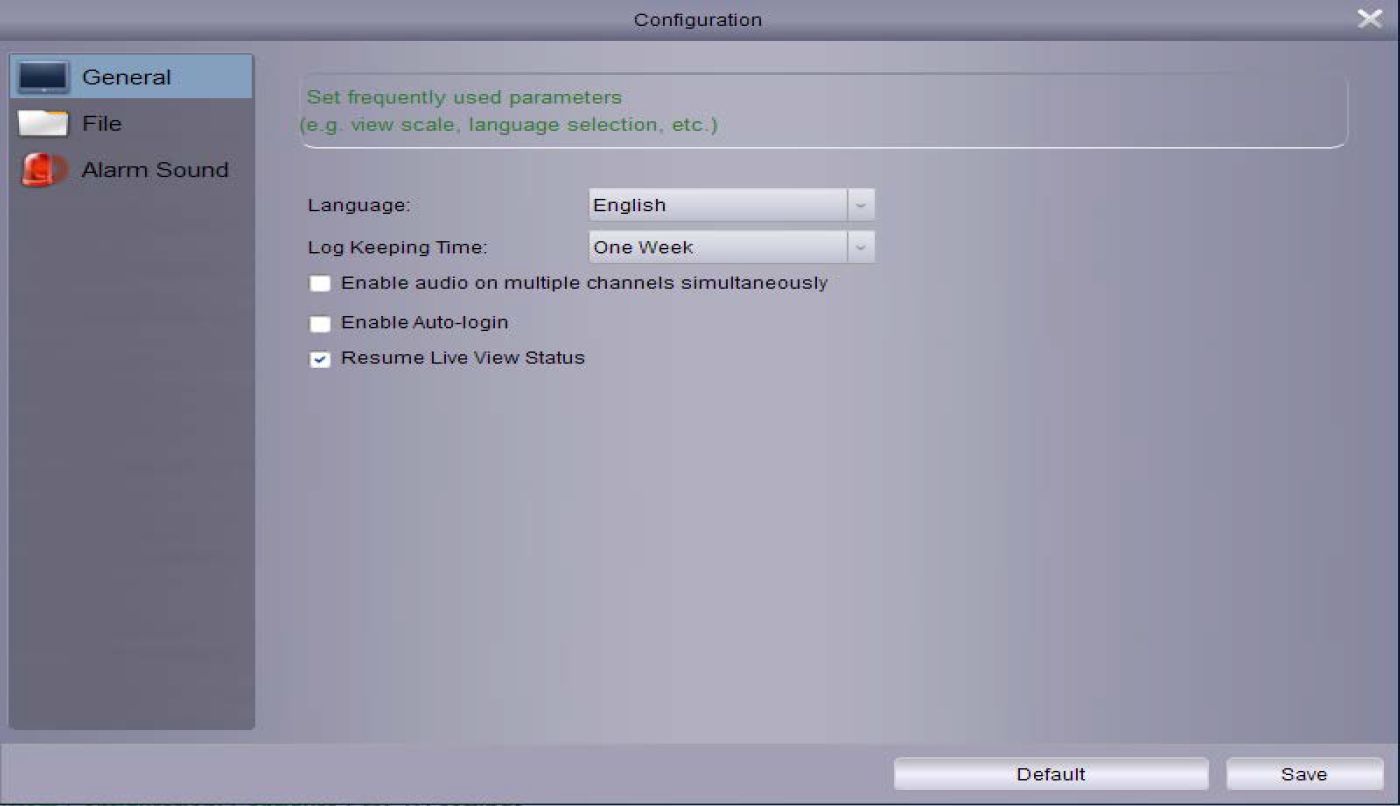
Configure general settings:
- Language: Select a language.
- Log Keeping Time: One week/Half month/One month.
- Enable audio on multiple channels simultaneously: Enable multi-channel audio output and play multi-channel audio.
- Enable auto-login: Automatically login without inputting account and password.
- Resume Live View Status: Open software and the last live view status will be automatically resumed.
– 37 –
Surveillance-client Software Operation Manual
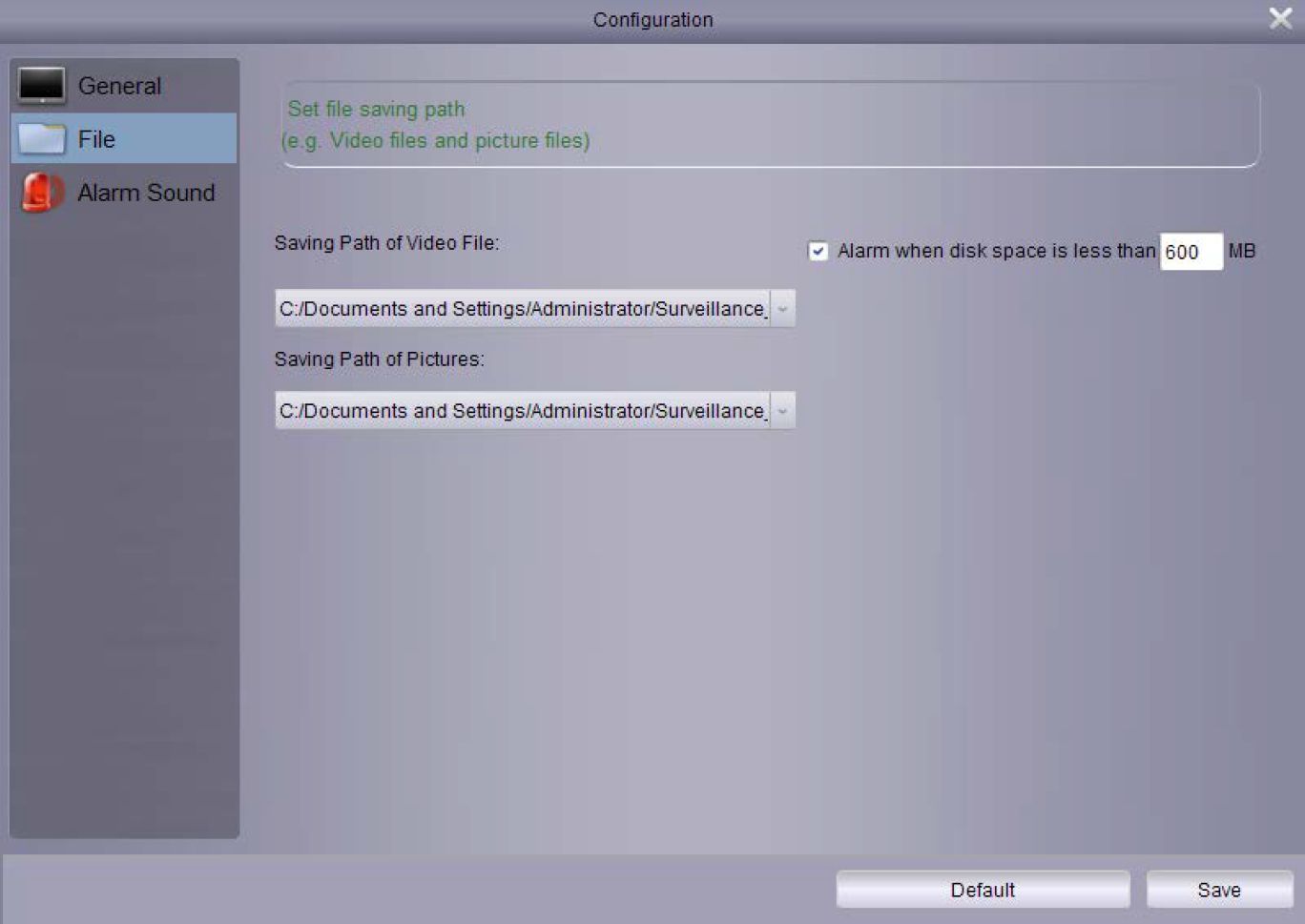
Set saving path of files (Video files and image files)
You can set an alarm message. When the disk space for saving files is less than the set space, the alarm message will appear. The default setting is 600MB.
Configure the folder for saving files:
Set alarm for insufficient disk space:
Alarm will appear if disk space is sufficient. When the disk space for saving is less than set space, the alarm will appear. The minimum value is 500MB.
– 38 –
Surveillance-client Software Operation Manual
Customize alarm sound: Allow you to configure alarm sound. You may use any WAV file to be the alarm sound.
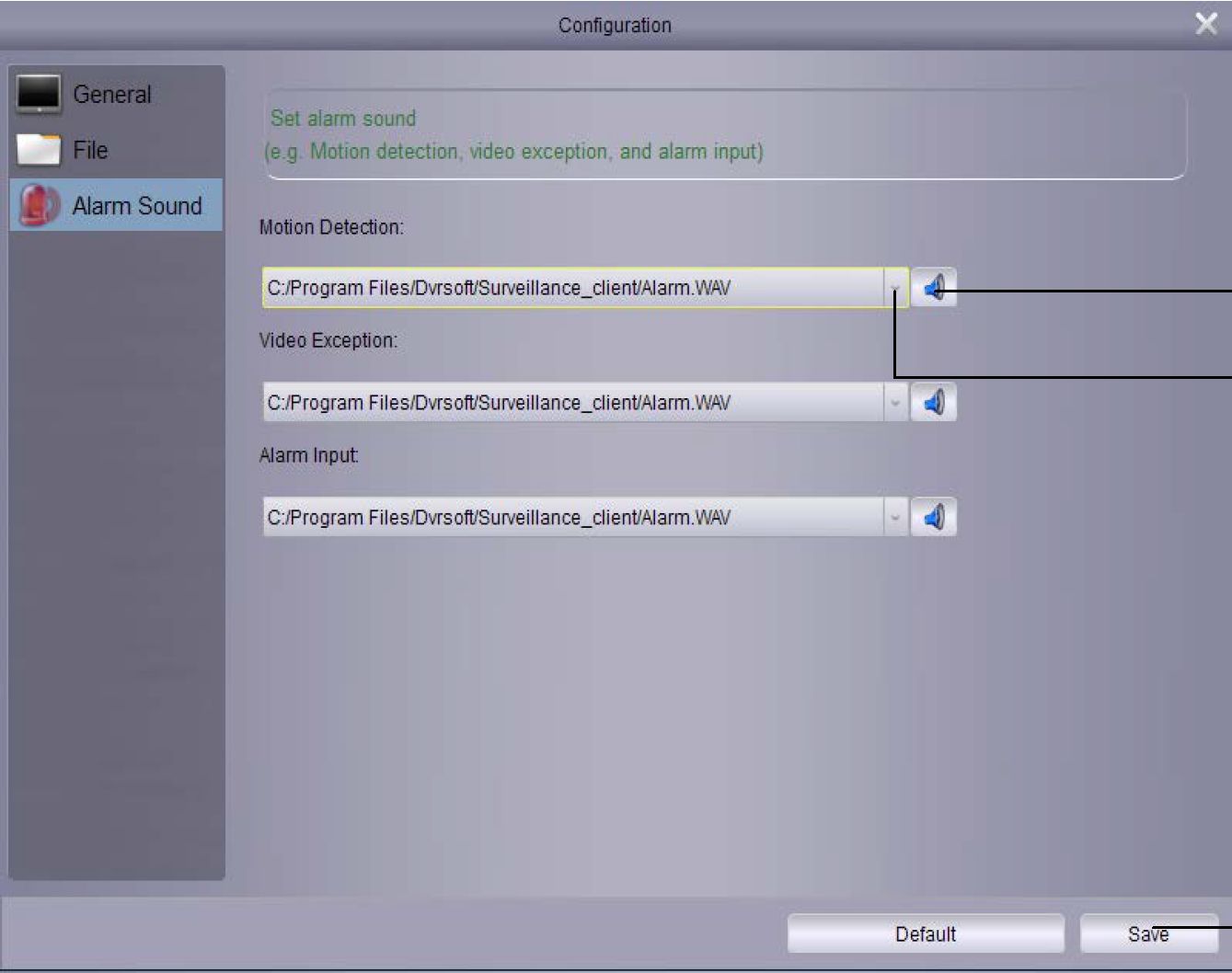
Play audio alarm
Click to select a
audio for alarm
(wav file)
Save
1 Add, modify and delete E-Map
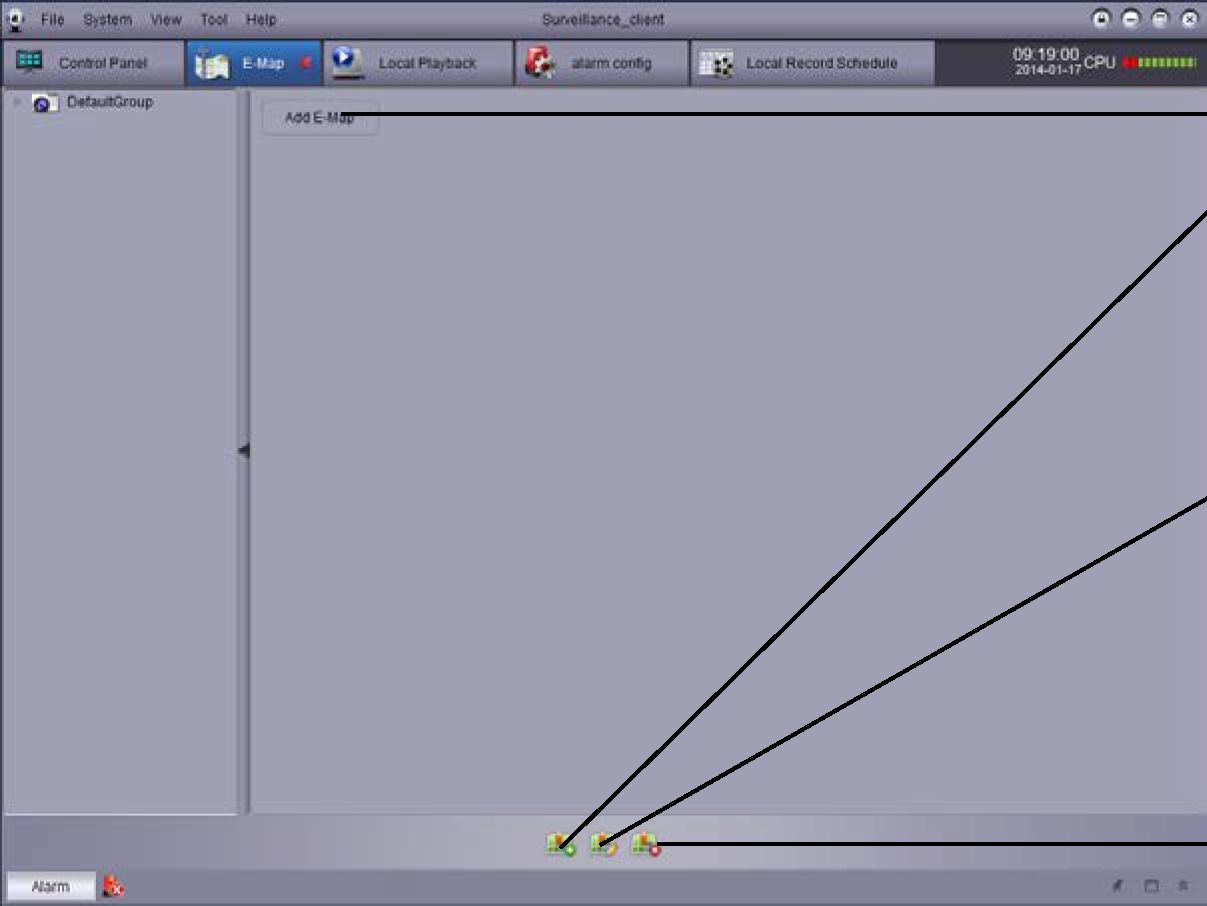
- Click “Add-E-Map” to add map
- Select the map to be modified and click Modify (to change the name and path of the map)
Add E-Map
Modify E-Map
Delete E-Map
– 39 –
Surveillance-client Software Operation Manual
4 Select the map to be deleted and click Delete
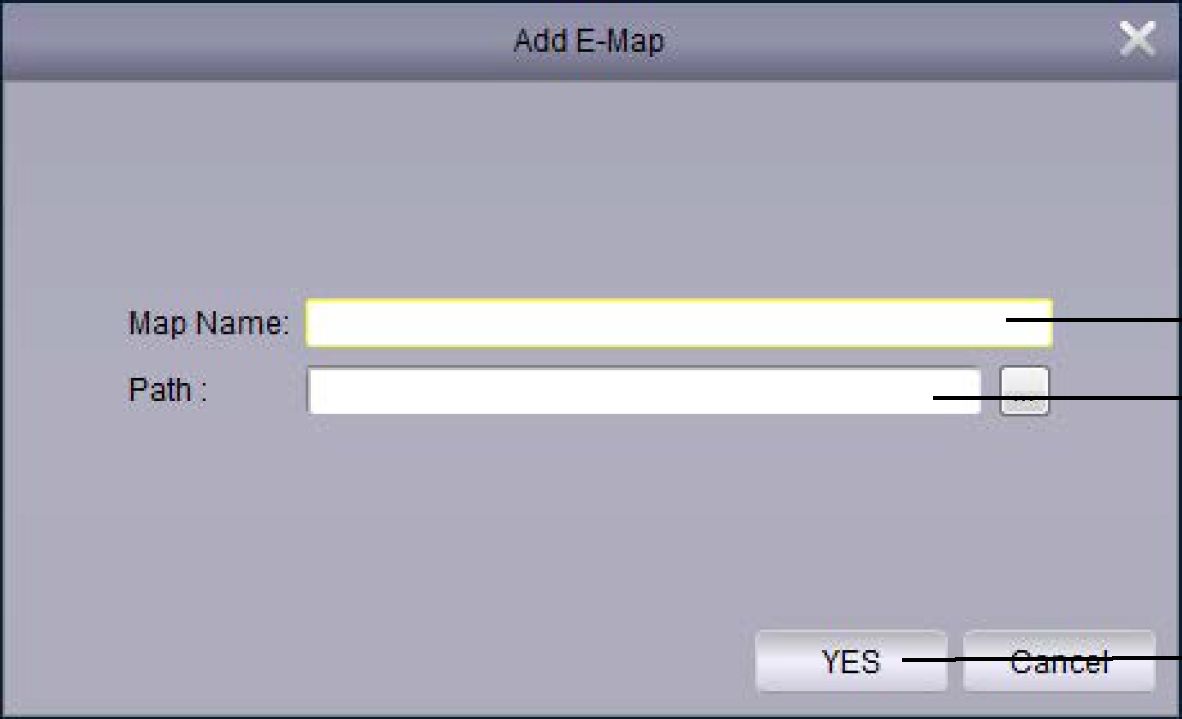
Click Yes to confirm
Map Name
Add Path
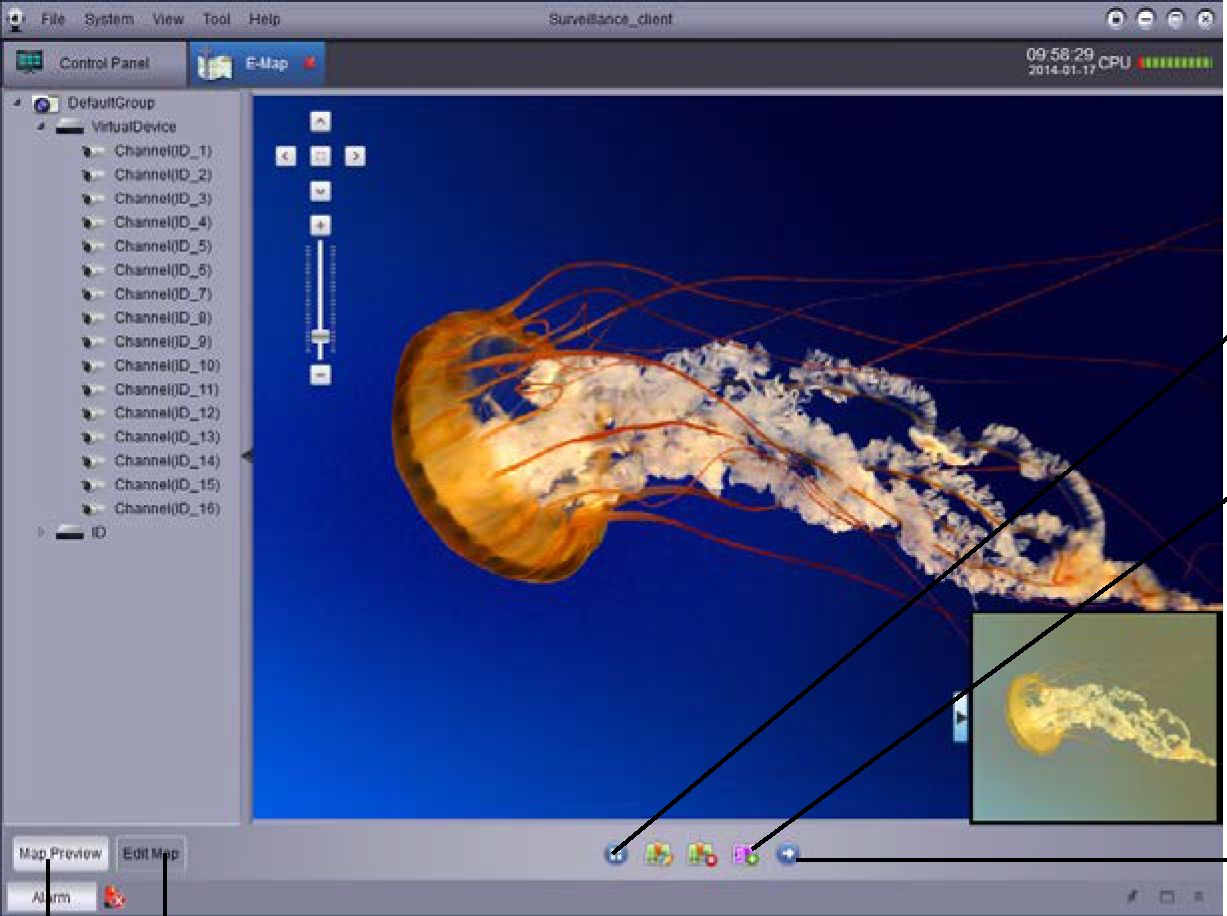
Return to map list
Hot spot
Forward
Map Map
Preview Preview
– 40 –
Surveillance-client Software Operation Manual
Enable
SynchronousPlayback
Select
DVR/Camera
Select Camera
Playback
Select File Type
Search Video
Previous period
Move to the right
Select Playing Date
| . . J| . J | ||
| 21 | 22] 23 j 24 ] 25 | 2Ö J 27 | | ||
| ■’ov.1.-. | ||
| .< – ■ 1 I-I4–I |
Click to select playing time
Amplify time

Zoom in/out
Narrow time period
03
03 c (/) o
£2
co
CD
(/)
C2 o
Mute
Screenshot 1
Cut video Download
03
O
Mute
– 41 –
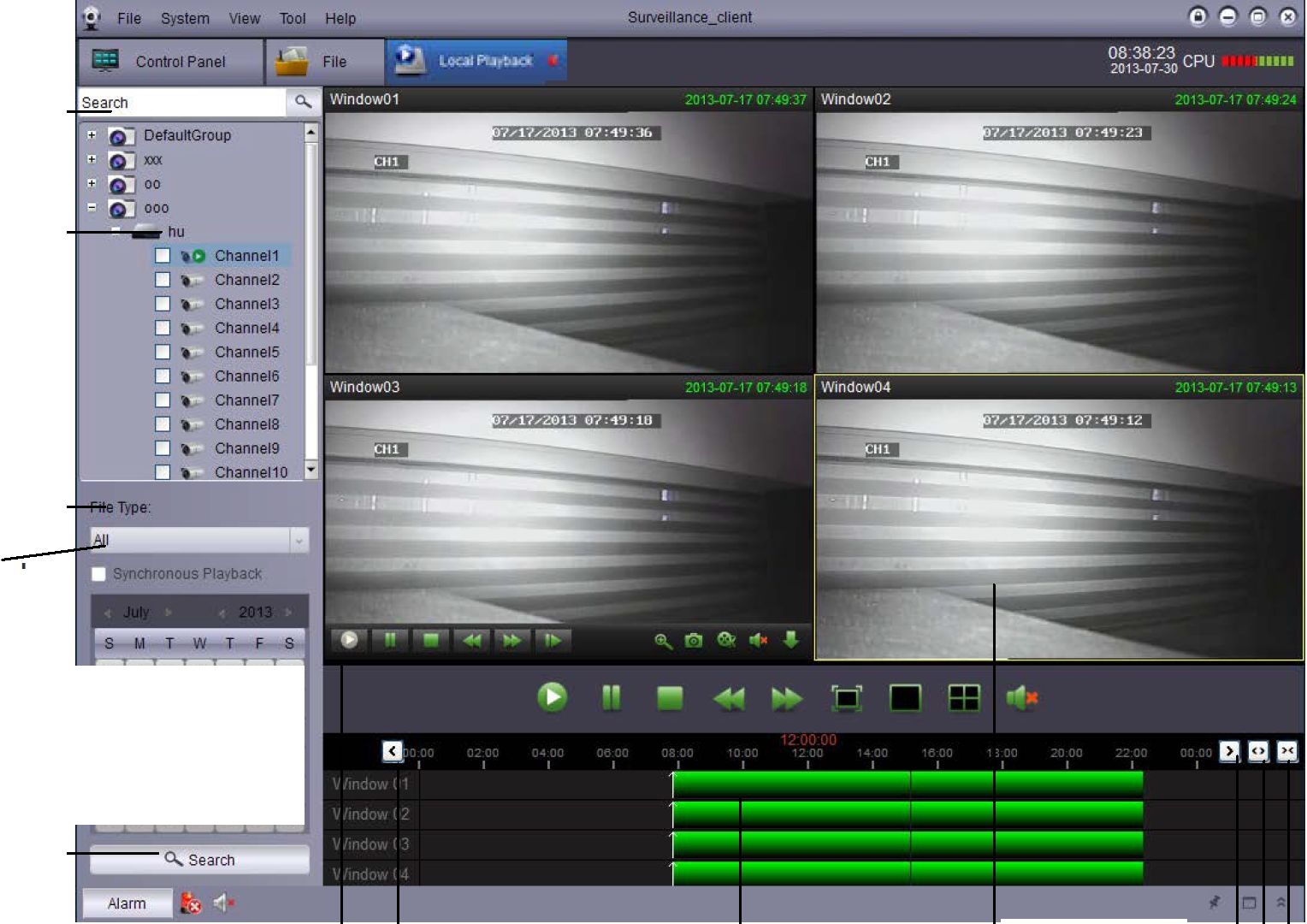

Surveillance-client Software Operation Manual
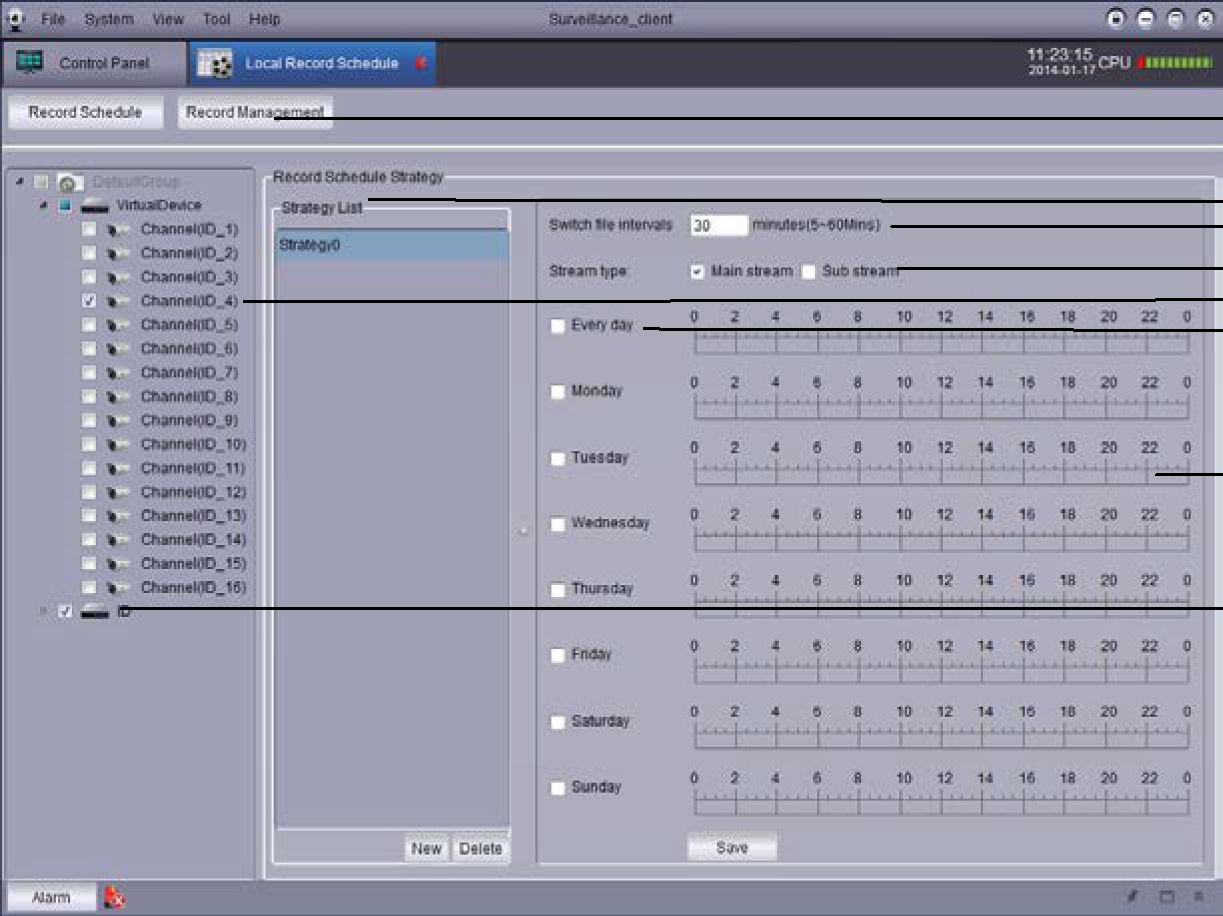
Record Management
Strategy list
Record time
Channel selection Stream type
Everyday
Record
Group device
- Select the whole group device or select a channel
- Select strategy 0 in the strategy list(you may create a new customized strategy)
- Select record time (5-60 min)
- Select stream type (Sub stream and Main stream)
- Select Everyday or a single day or days
- Select record time(by time period)
- Click Save
- Record Setting
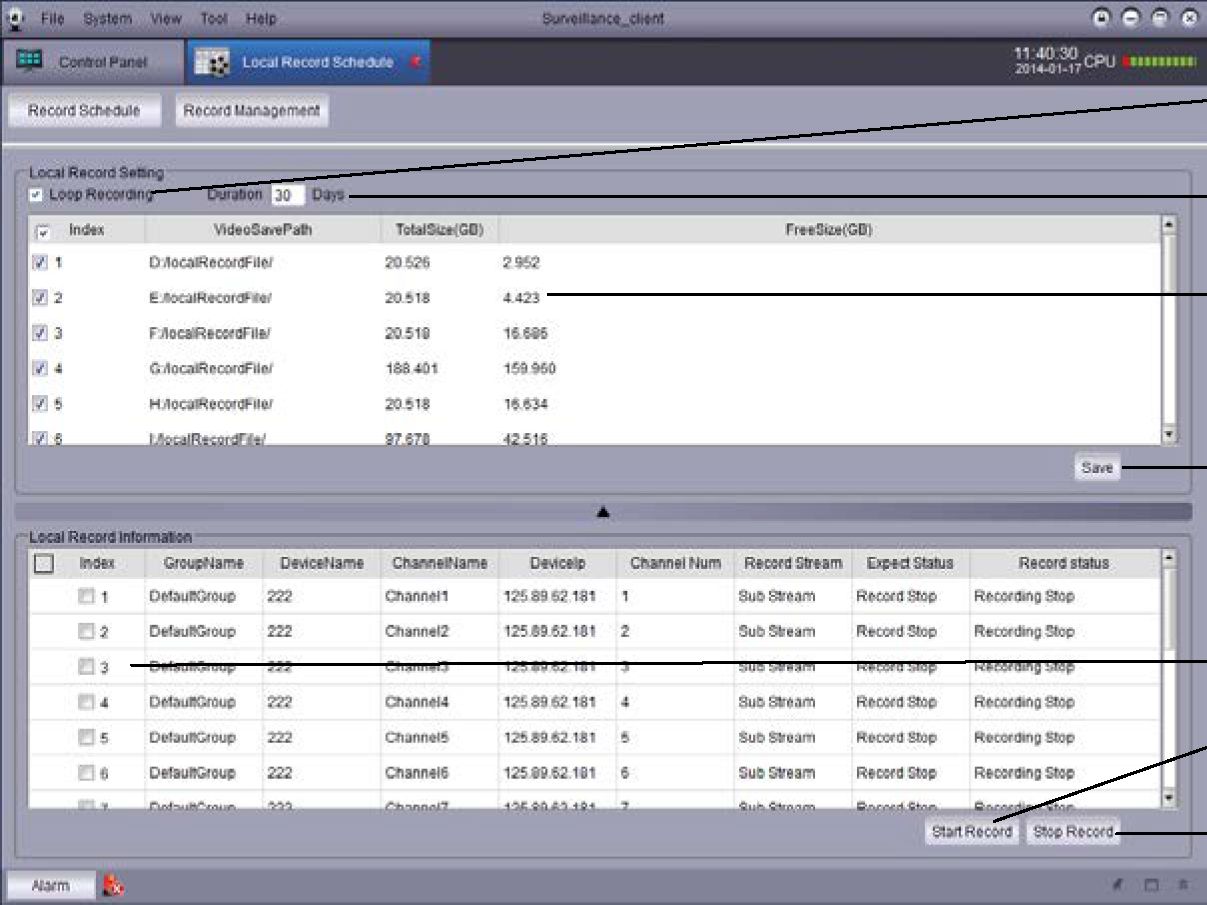
Loop recording
Duration
Record drive letter
Save
Channel
Start rec ord
Stop record
1 Select record drive letter (Select loop recording and duration as required)
2 Save drive letter
– 42 –
Surveillance-client Software Operation Manual
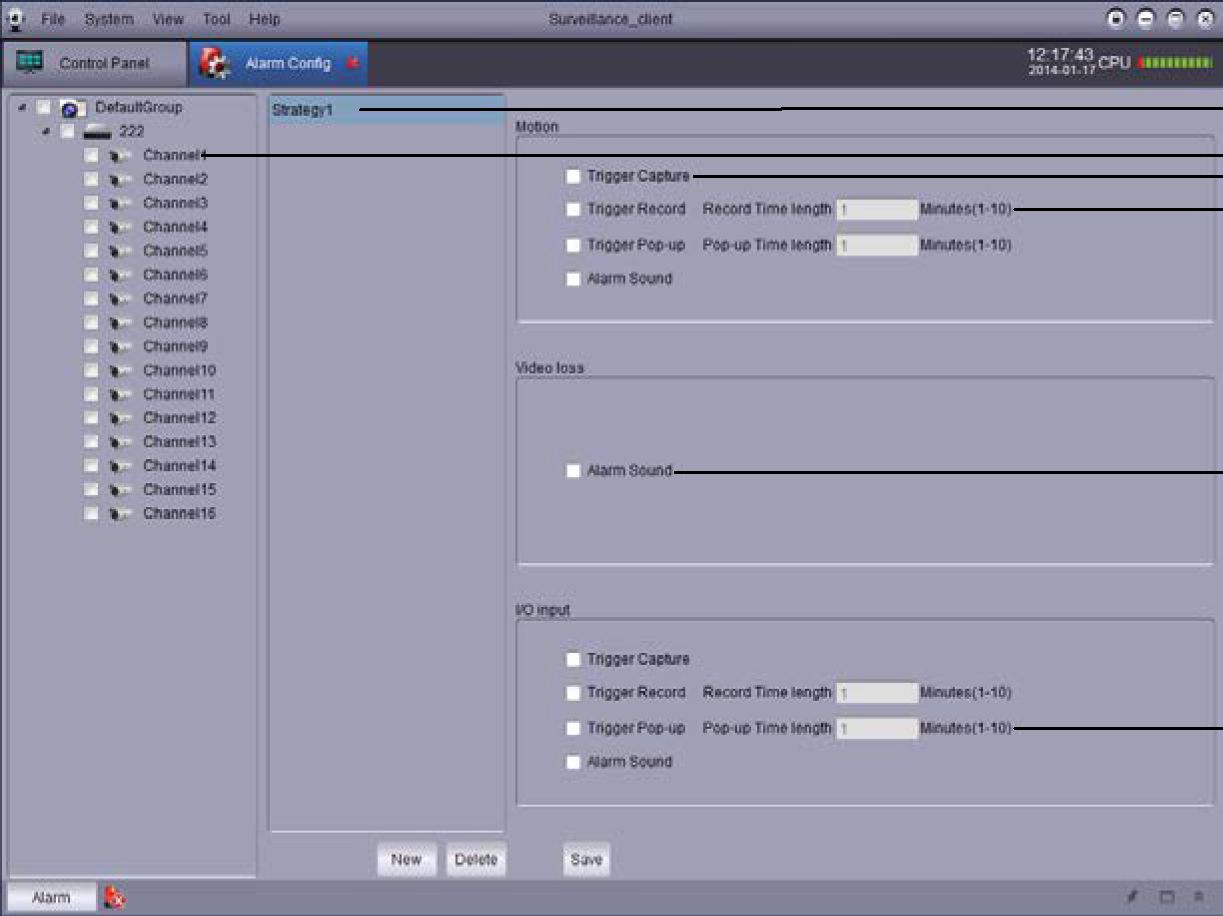
Strategy list
Channel selection Trigger capture
Trigger record and record time
length
Alarm sound
Trigger pop-up and pop-up time
length
- Alarm type: motion detection, video loss, I/O alarm
- Select alarm record channels (single channel, multiple channels and select all)
- Select capture
- Select trigger record and record time length
- Select trigger pop-up and pop-up time length
- Select alarm sound
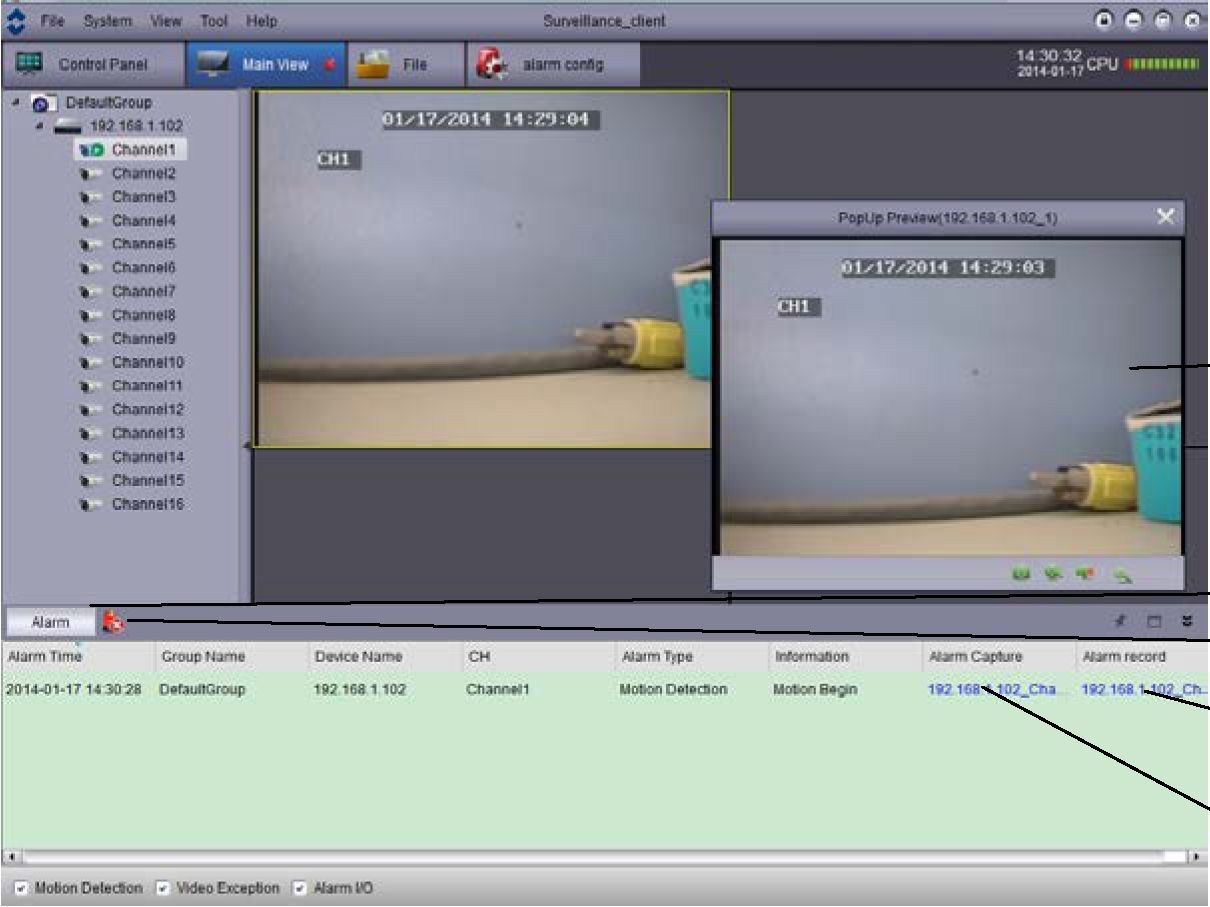
Alarm page
Clear alarm messages
Alarm trigger popup
Alarm record
Alarm capture
– 43 –
